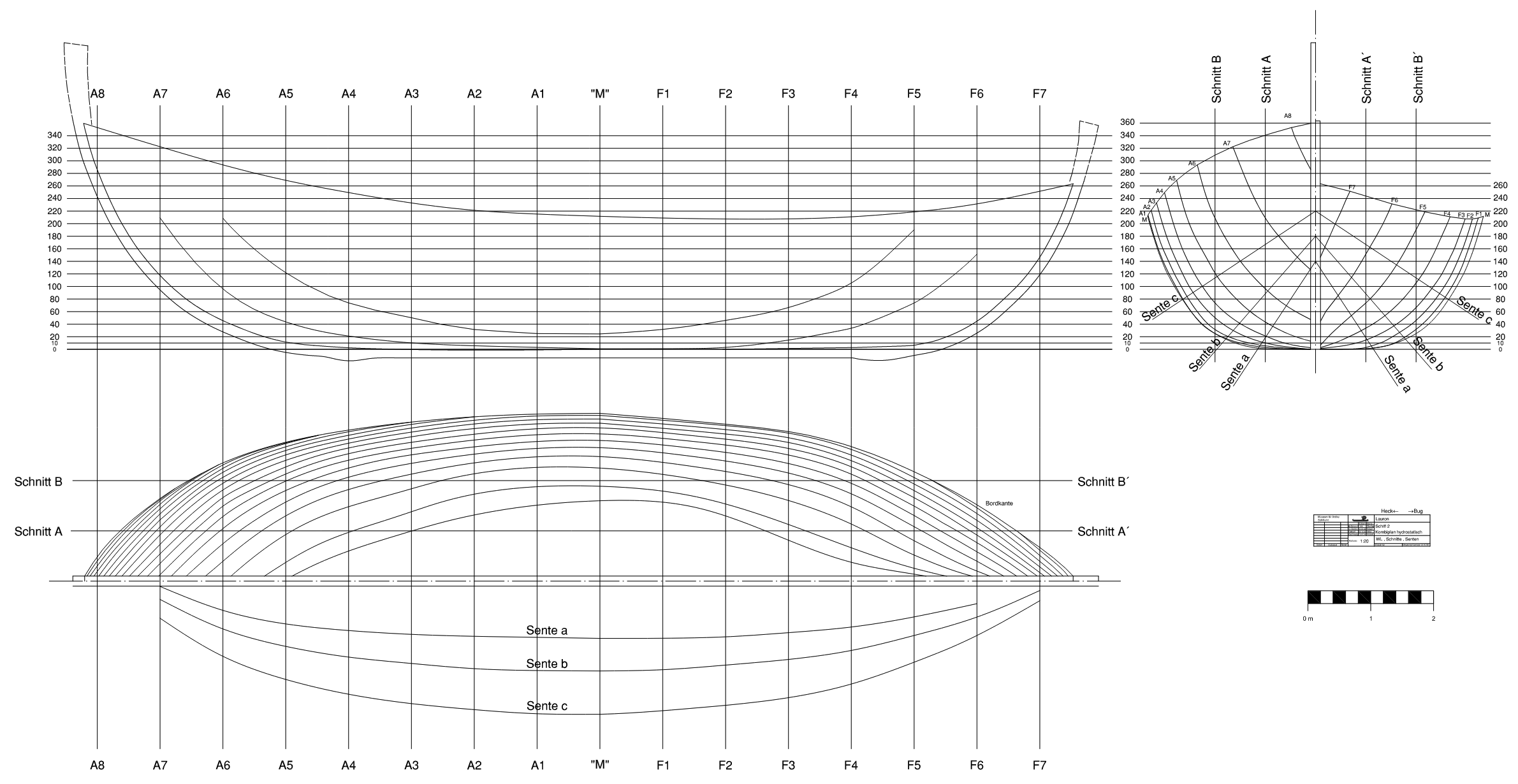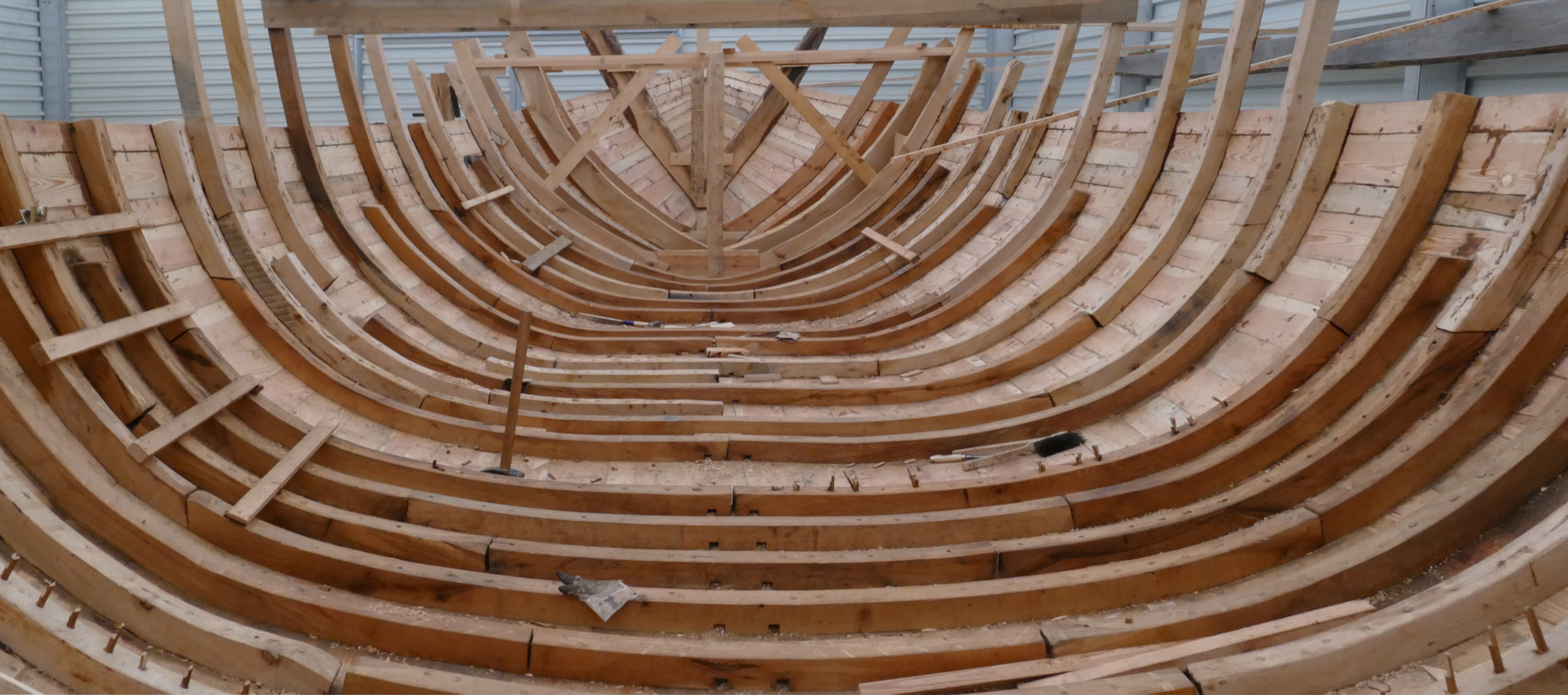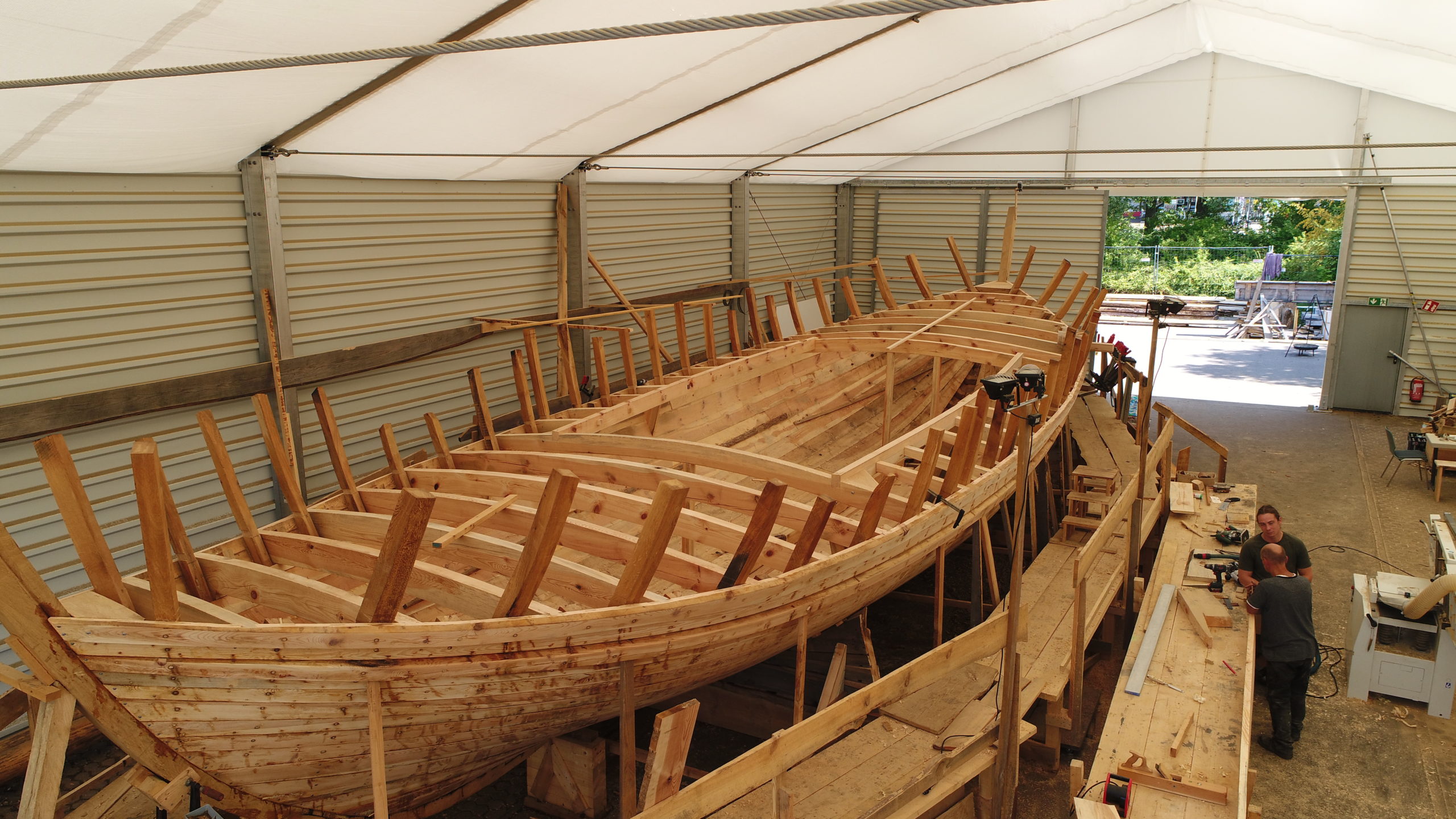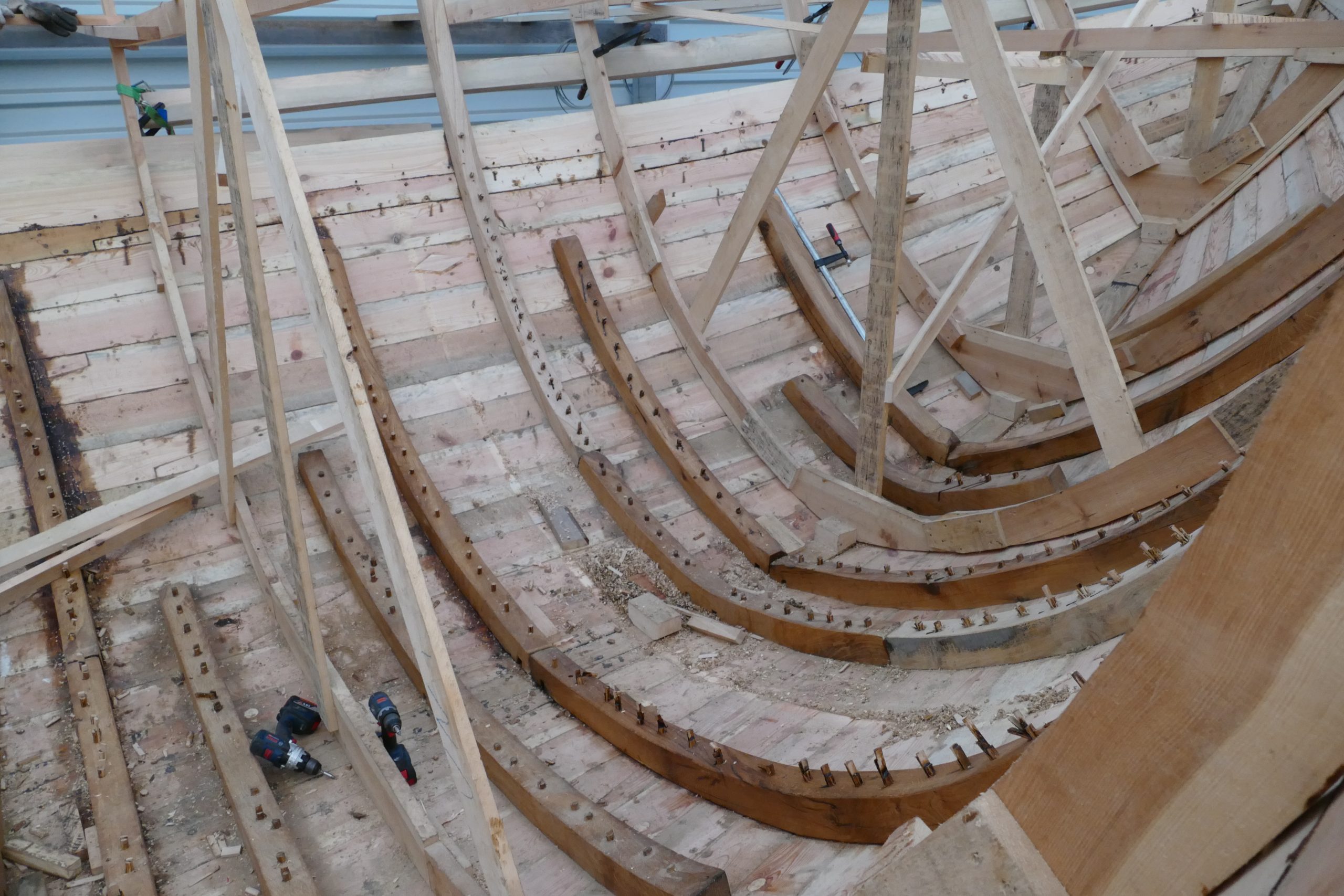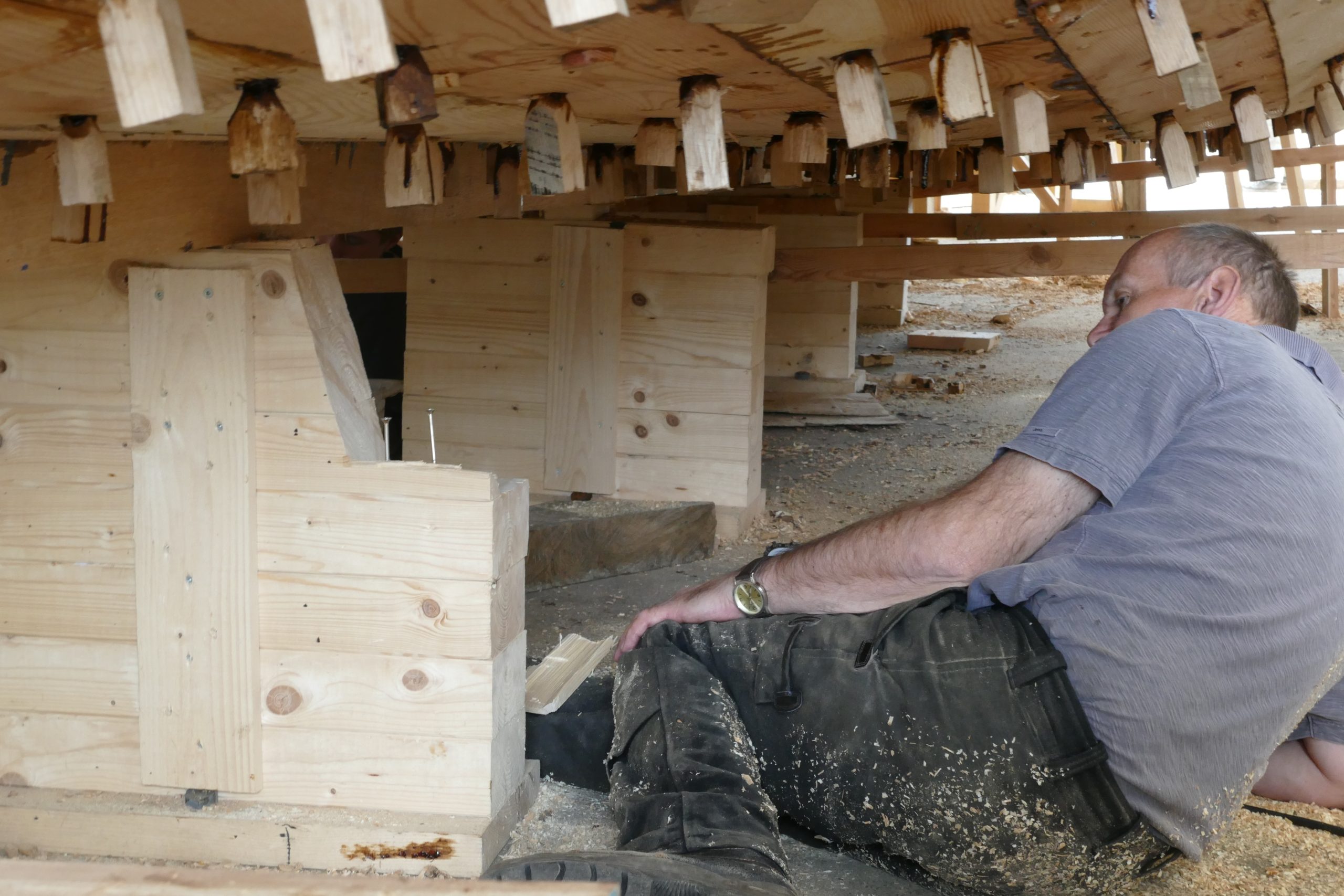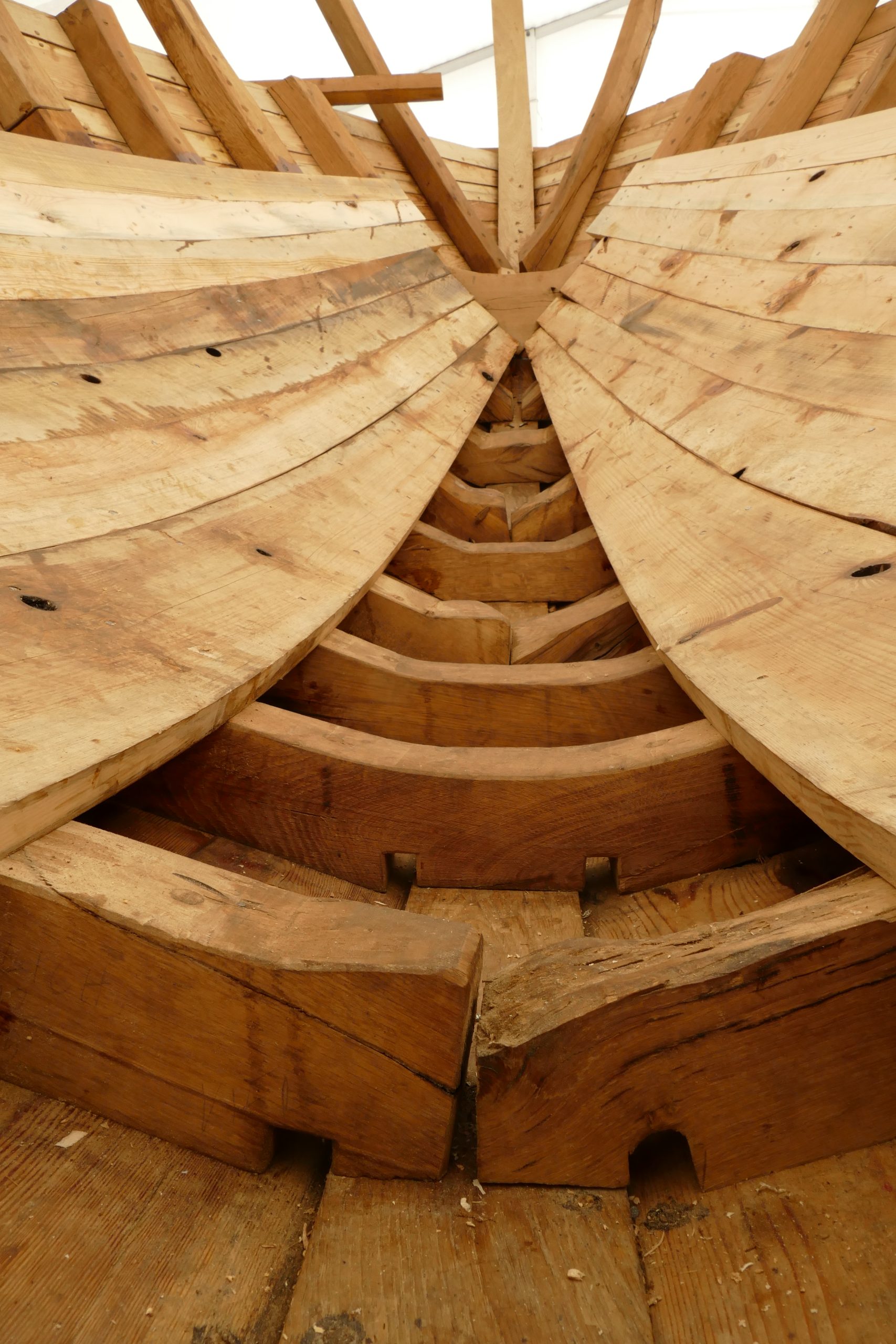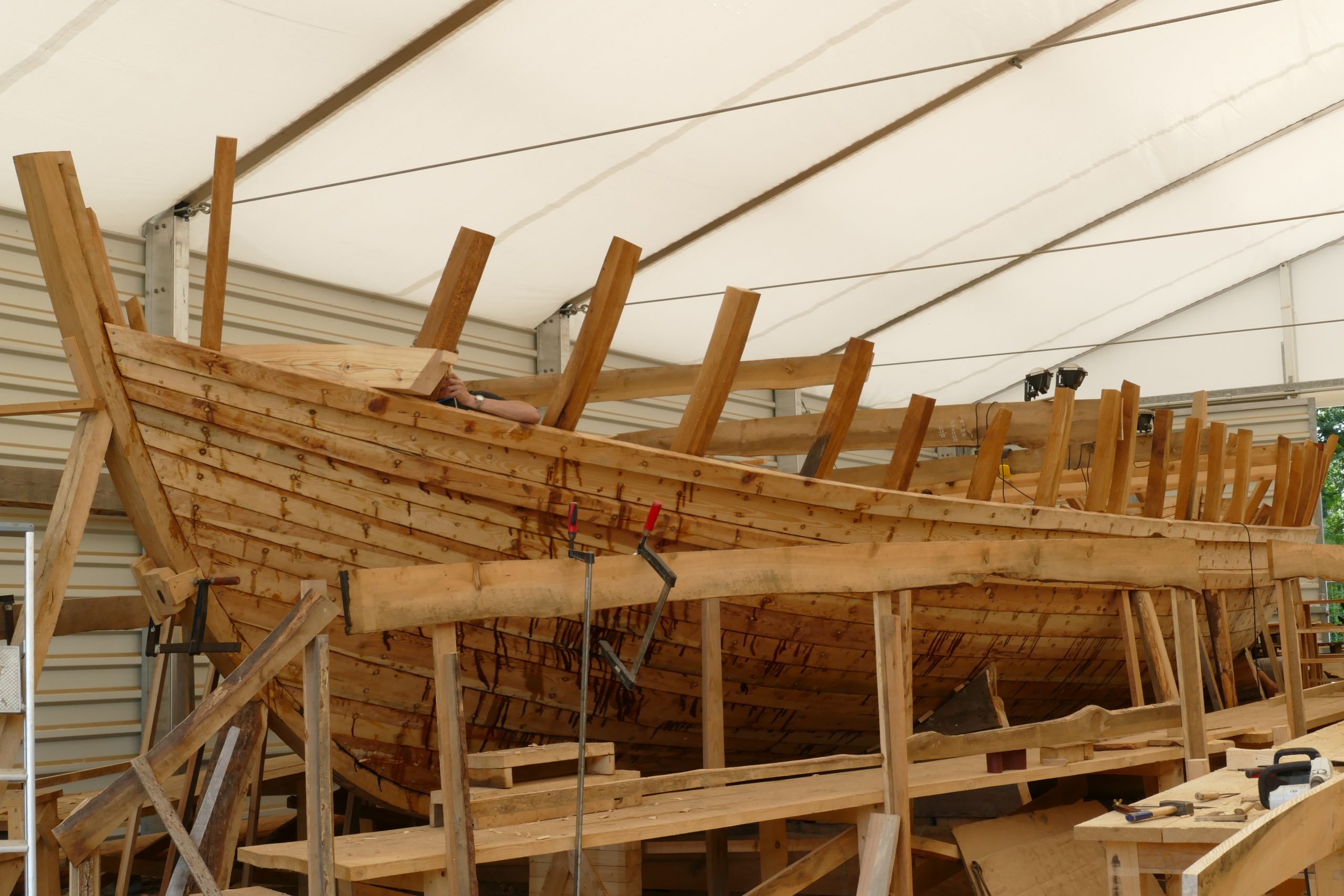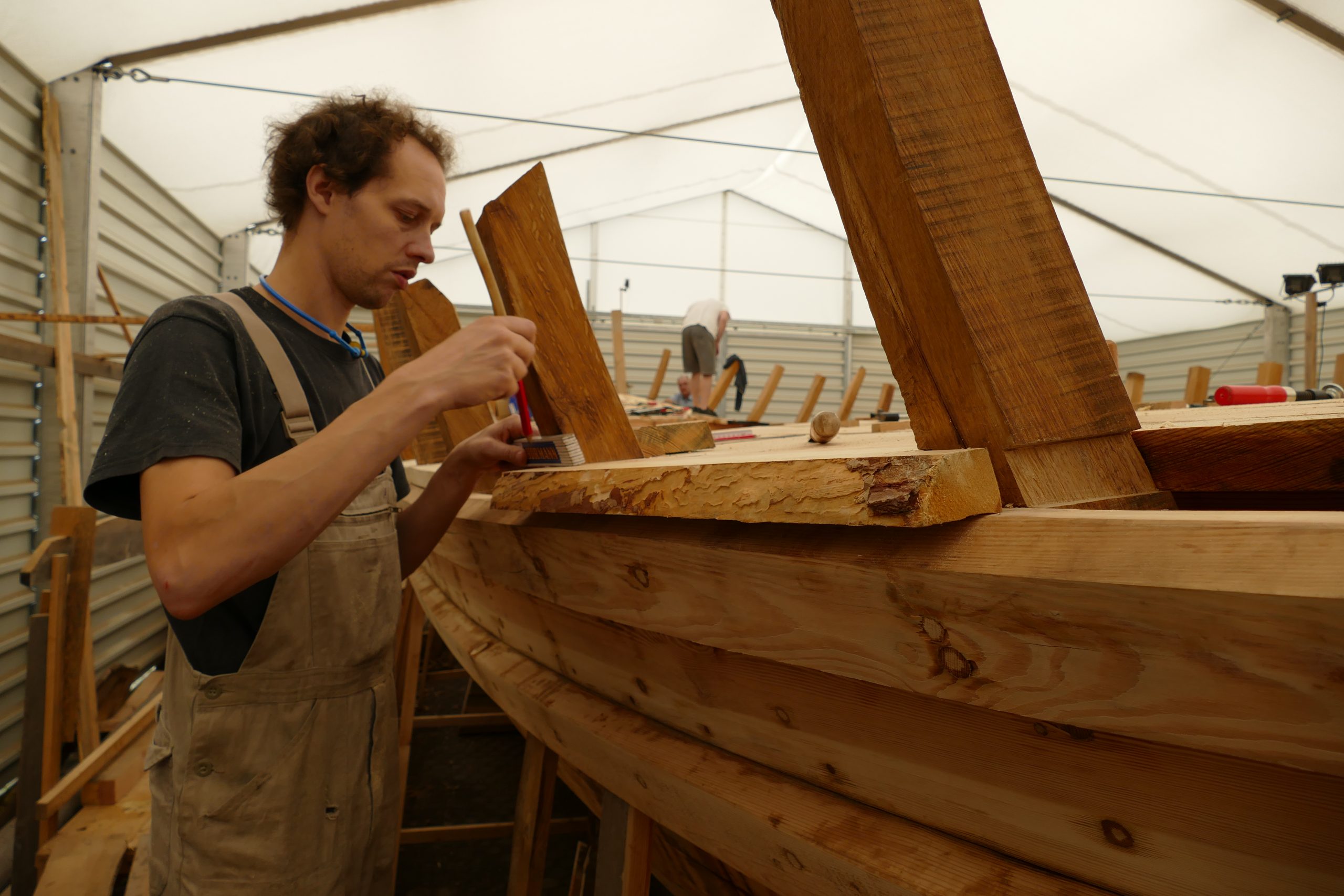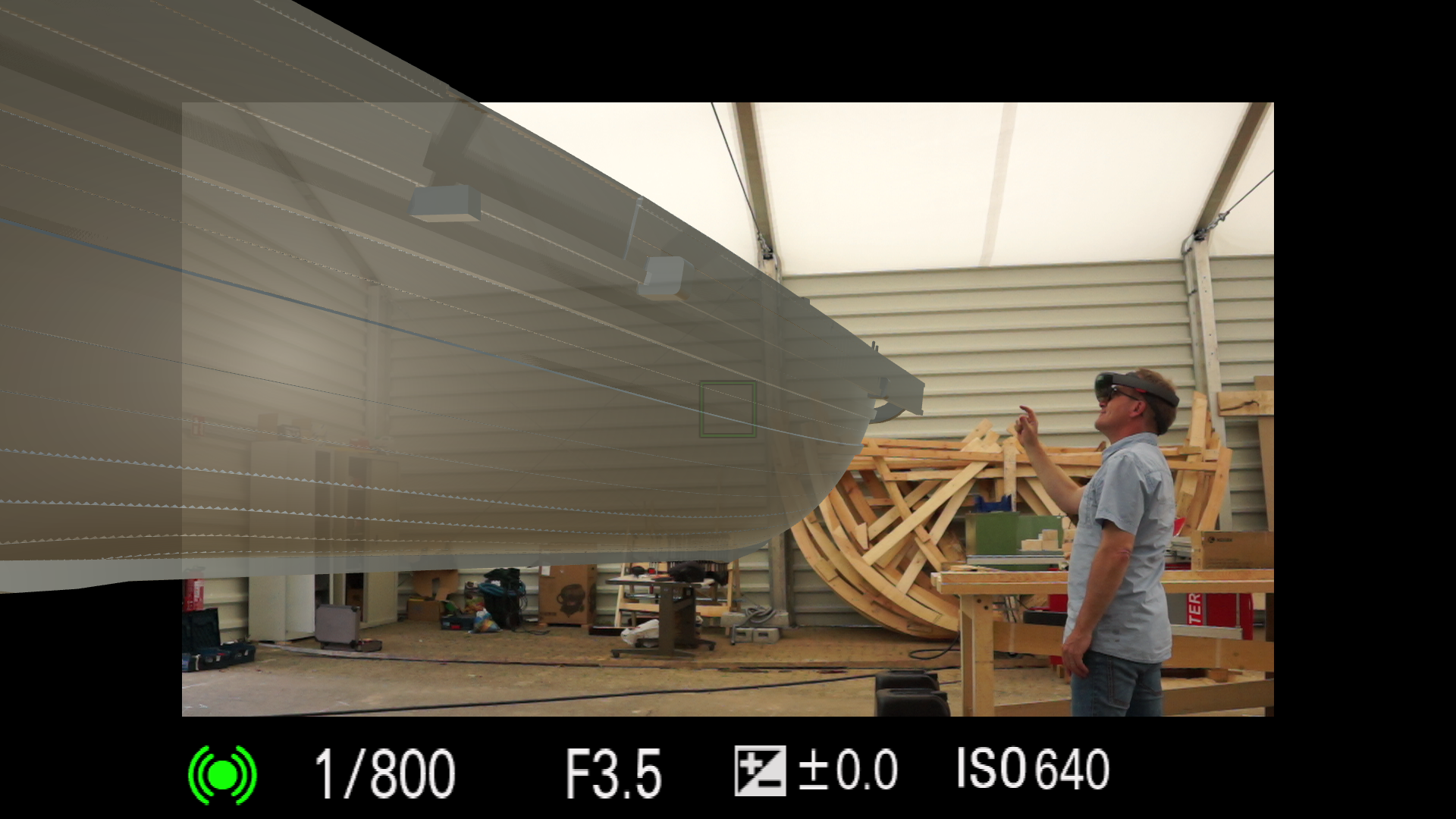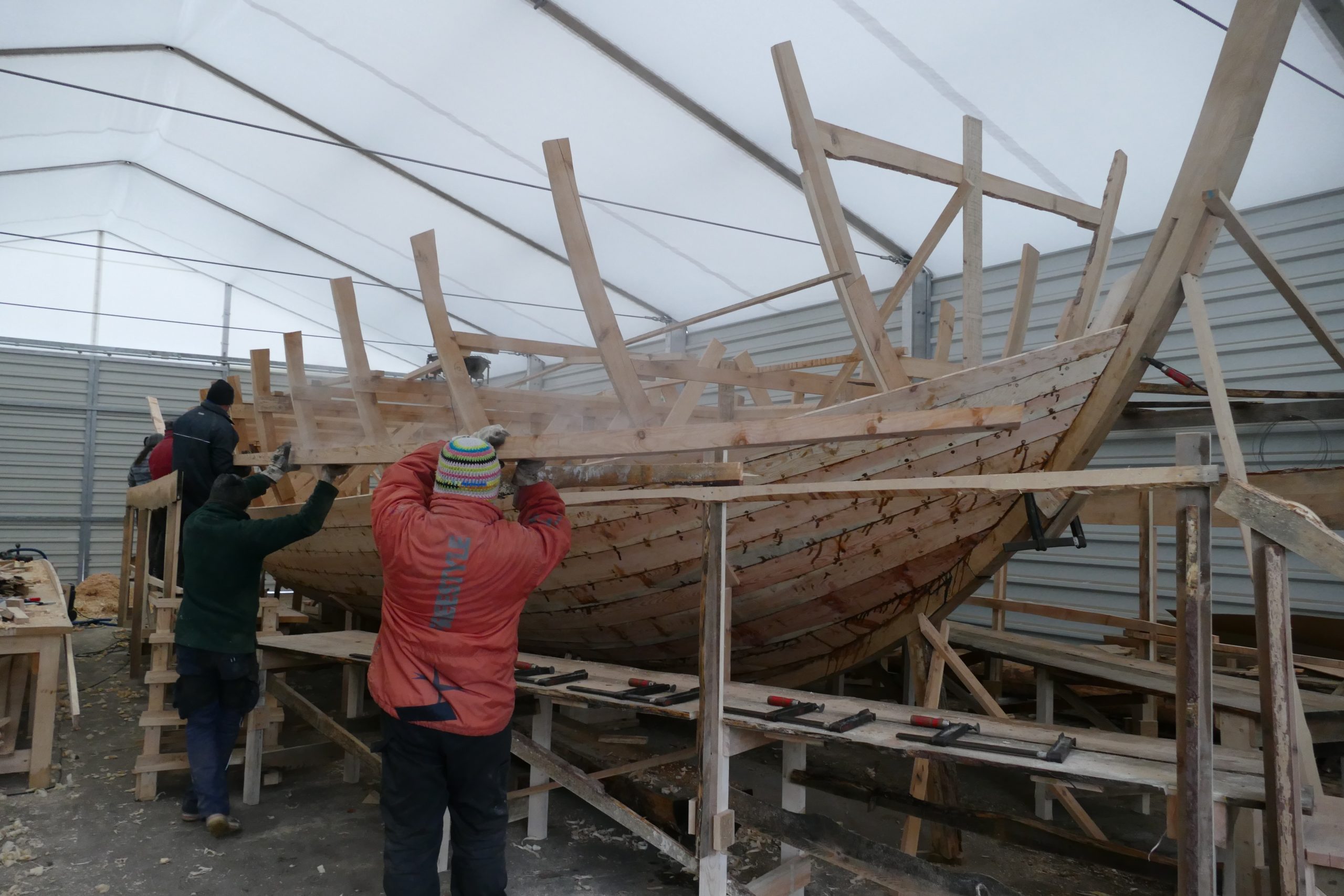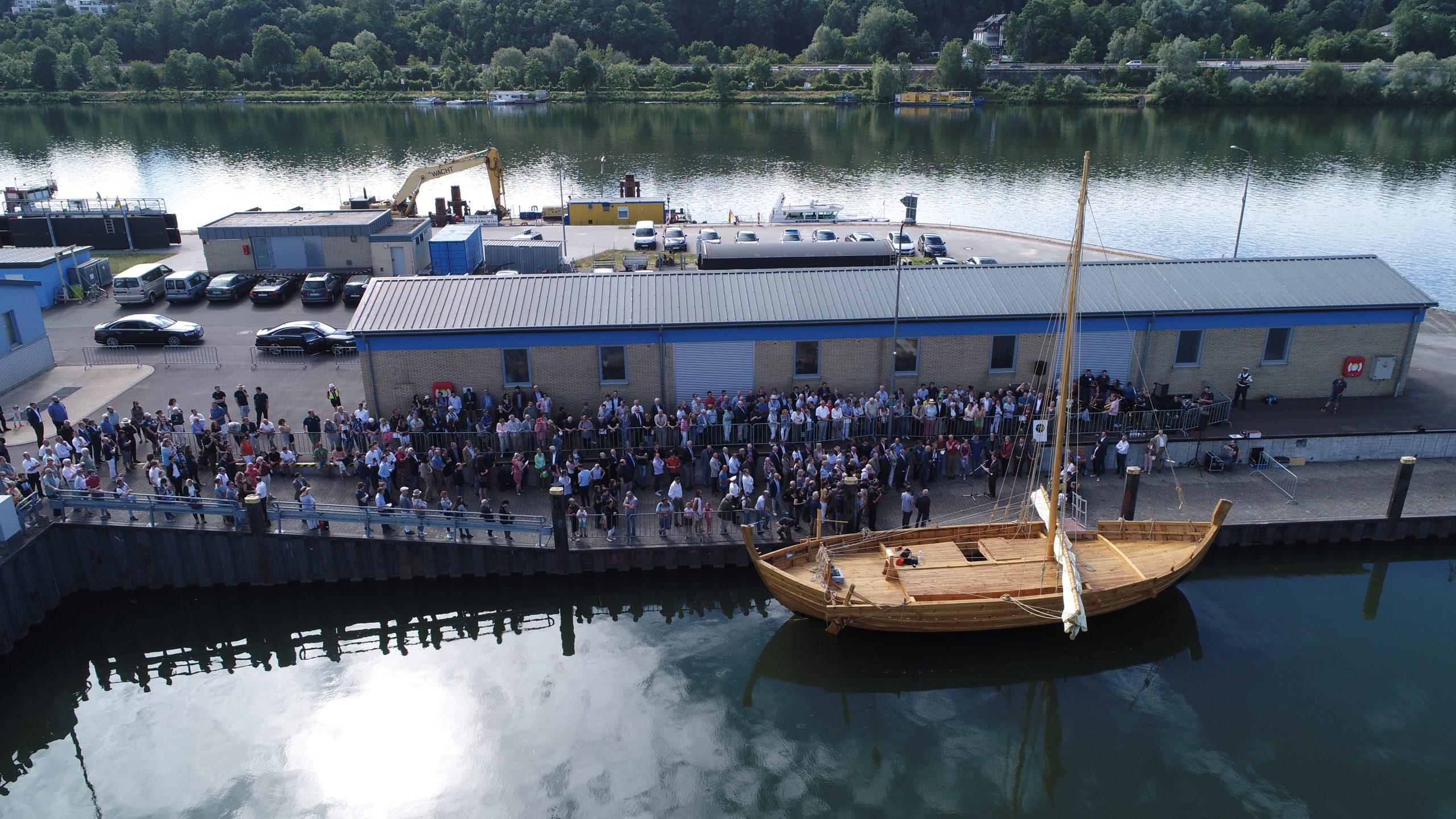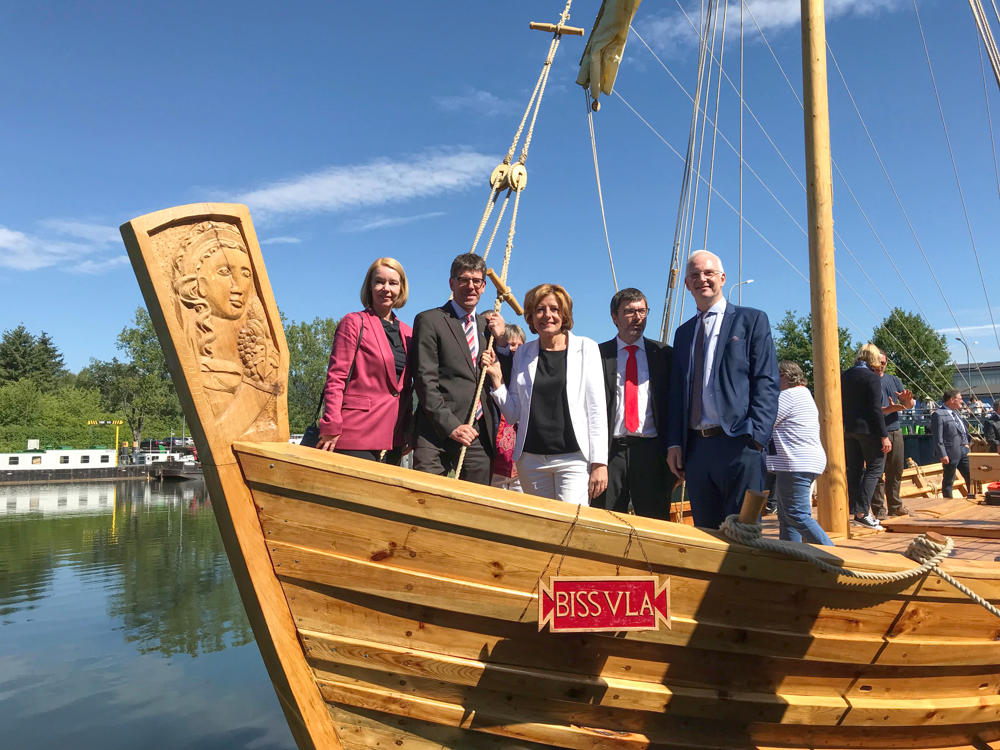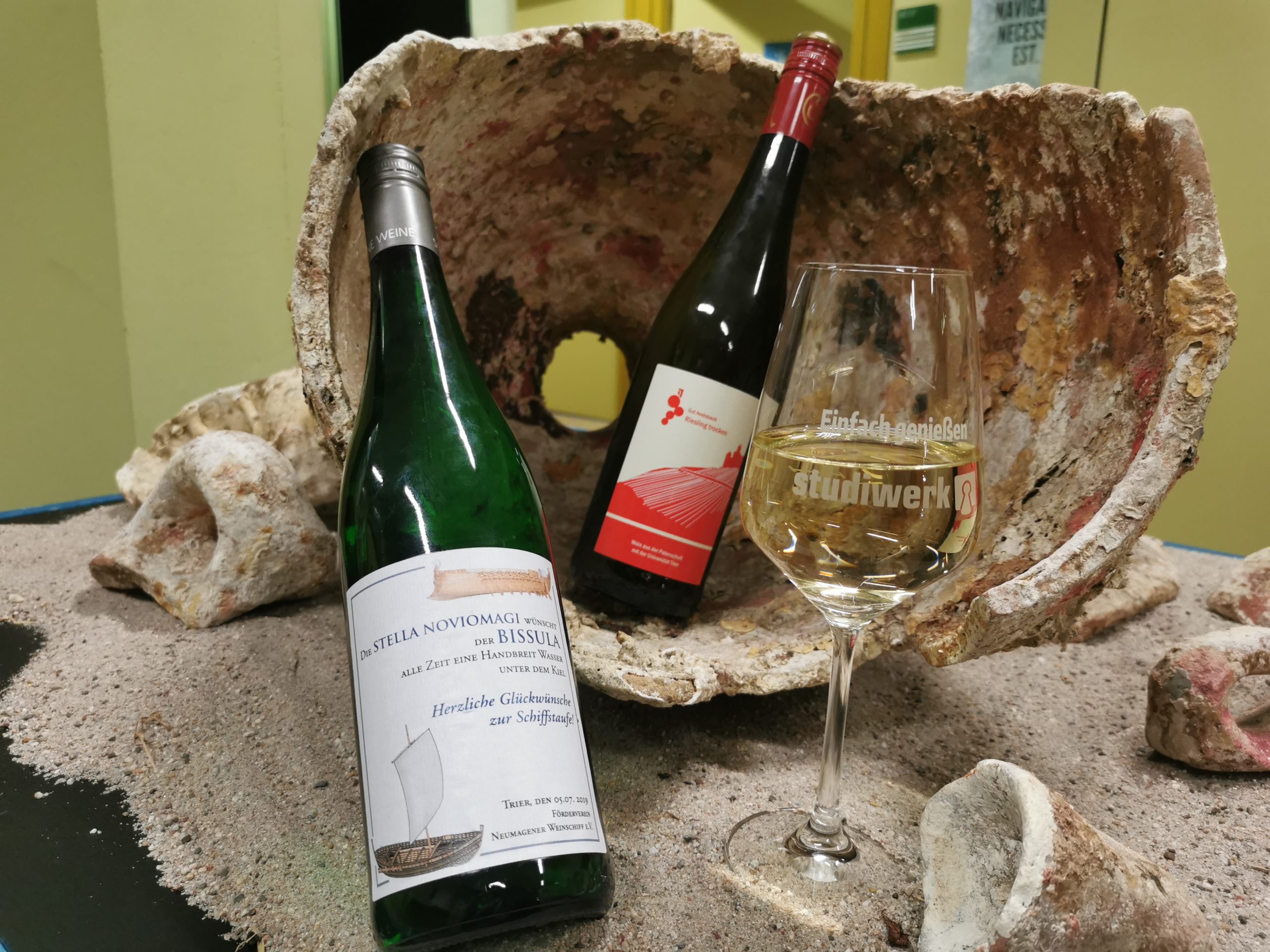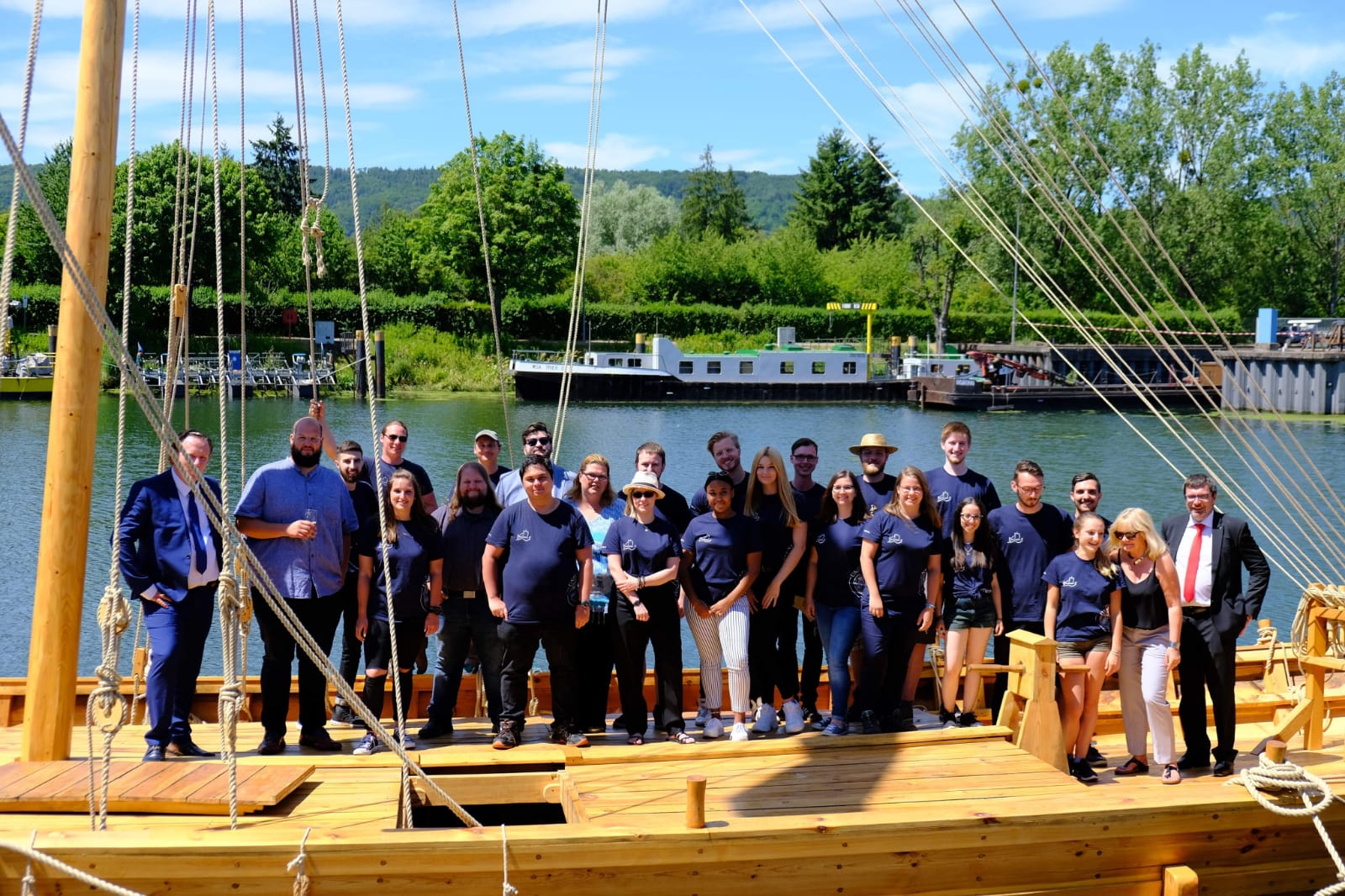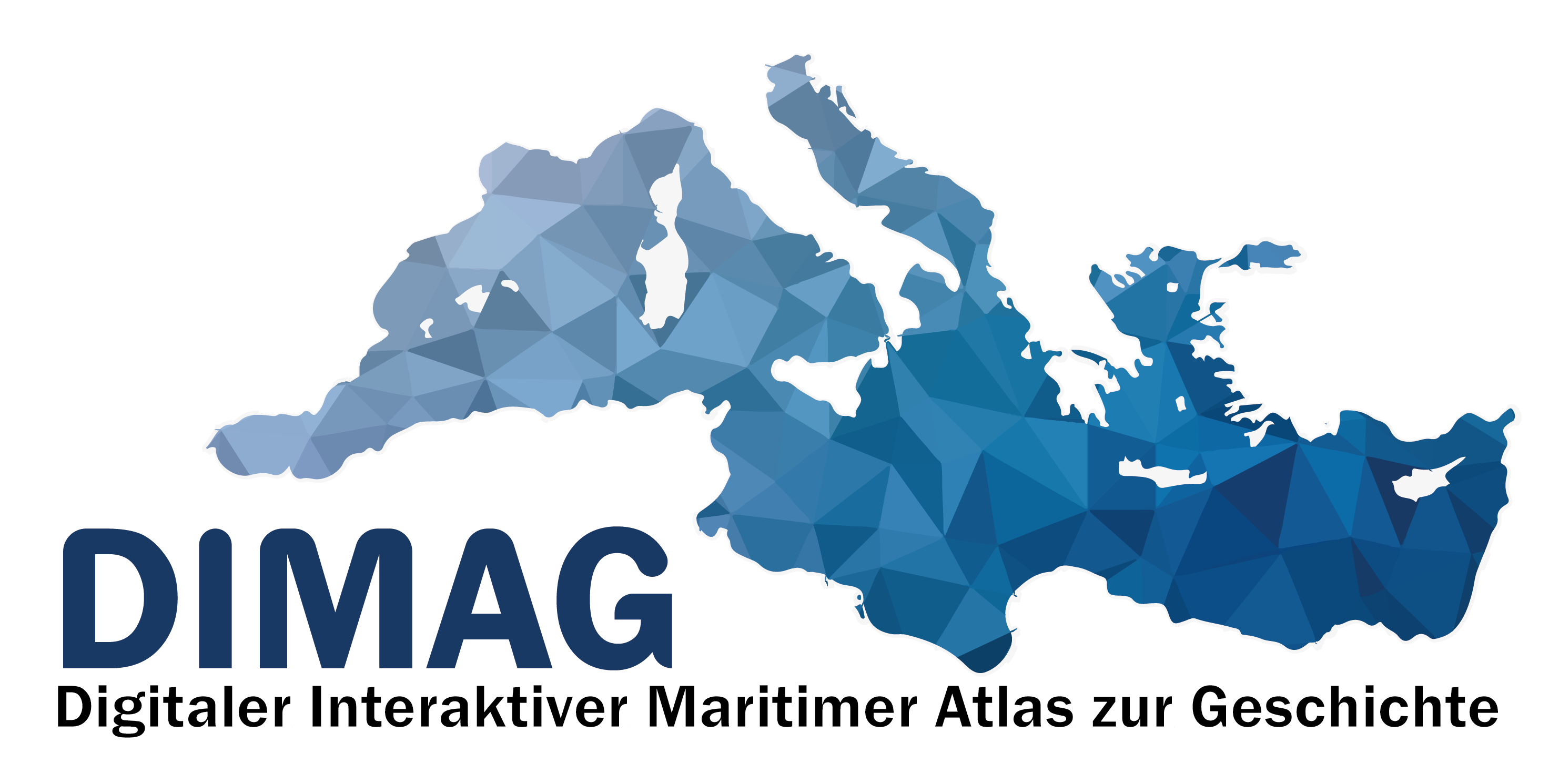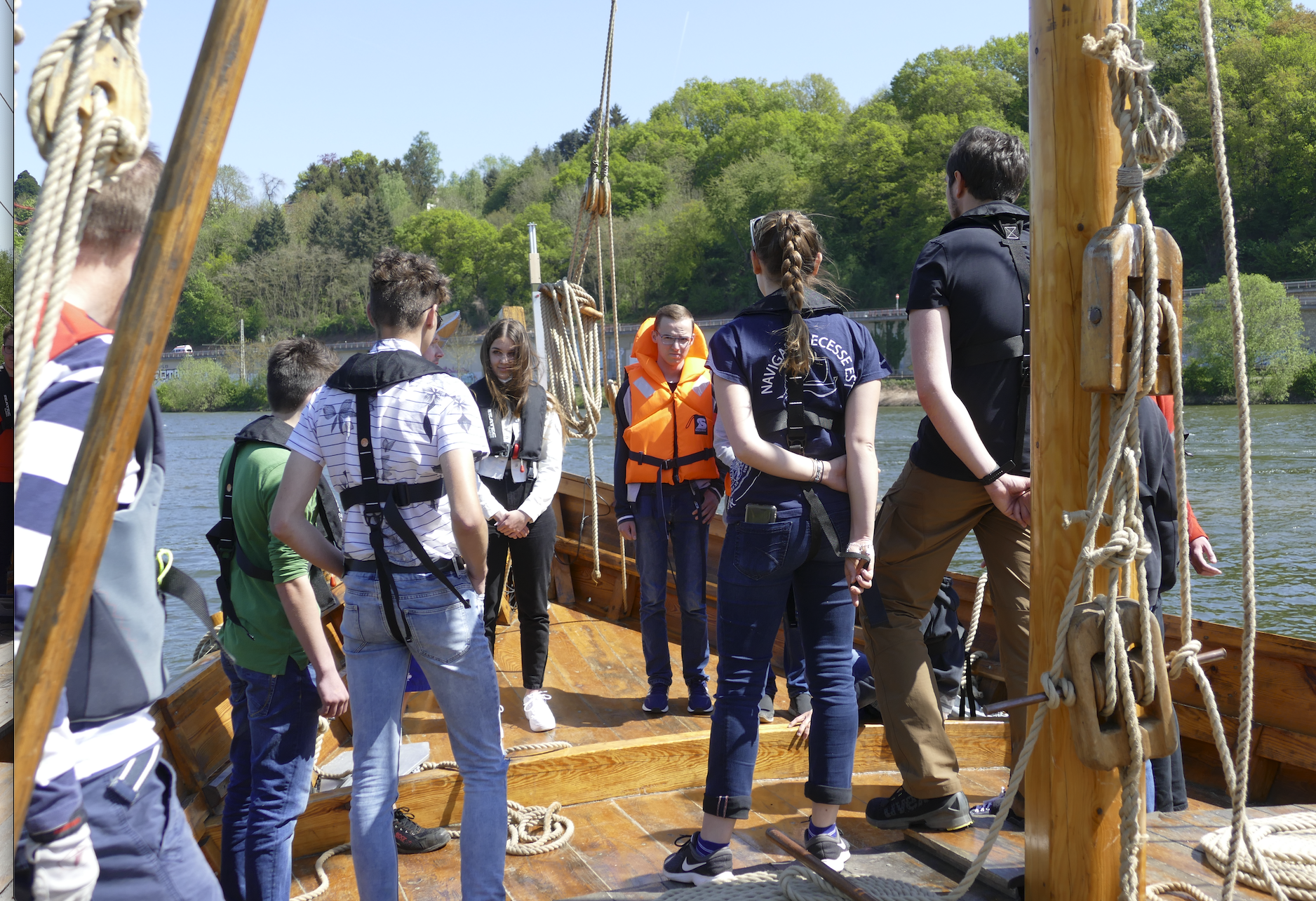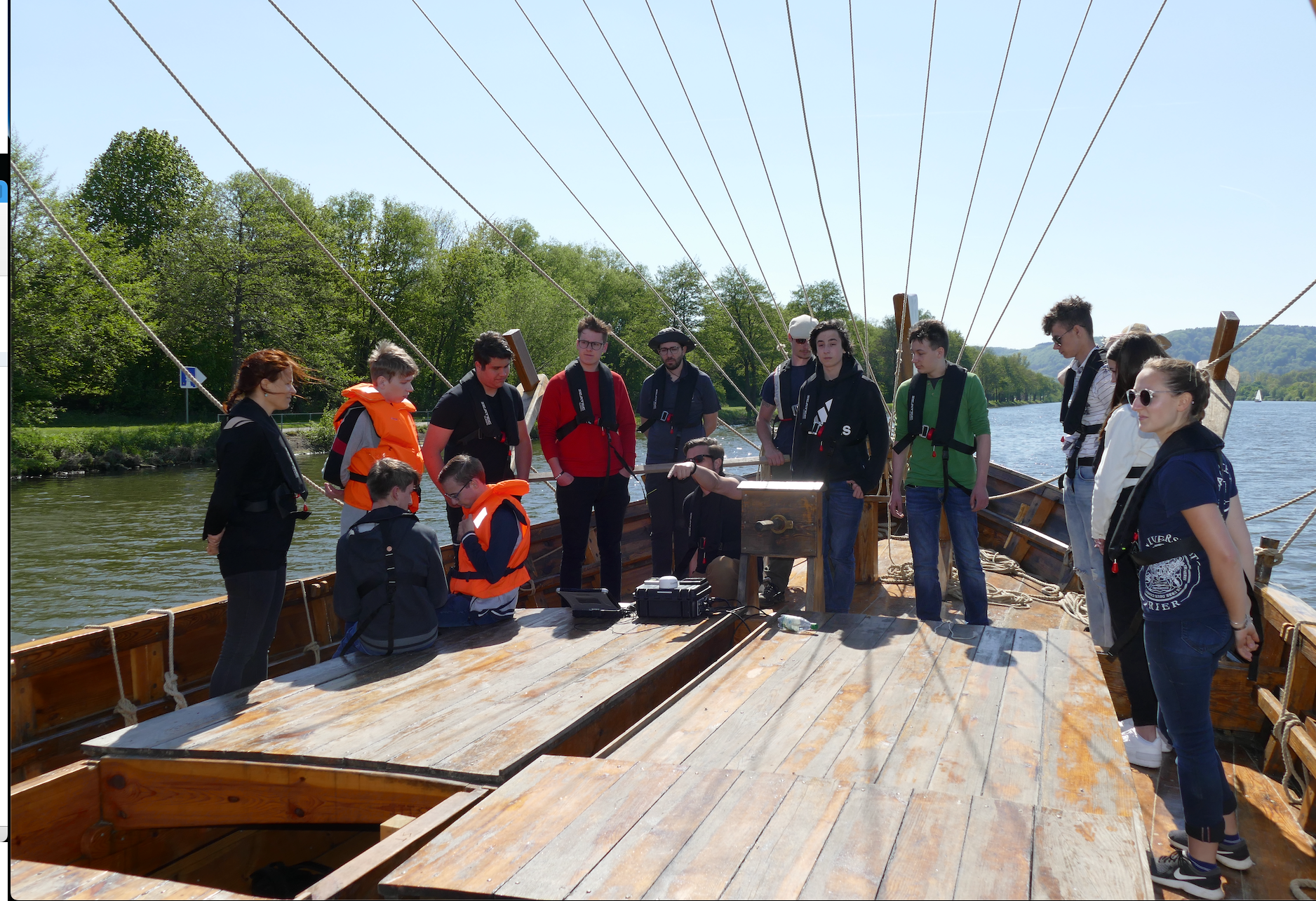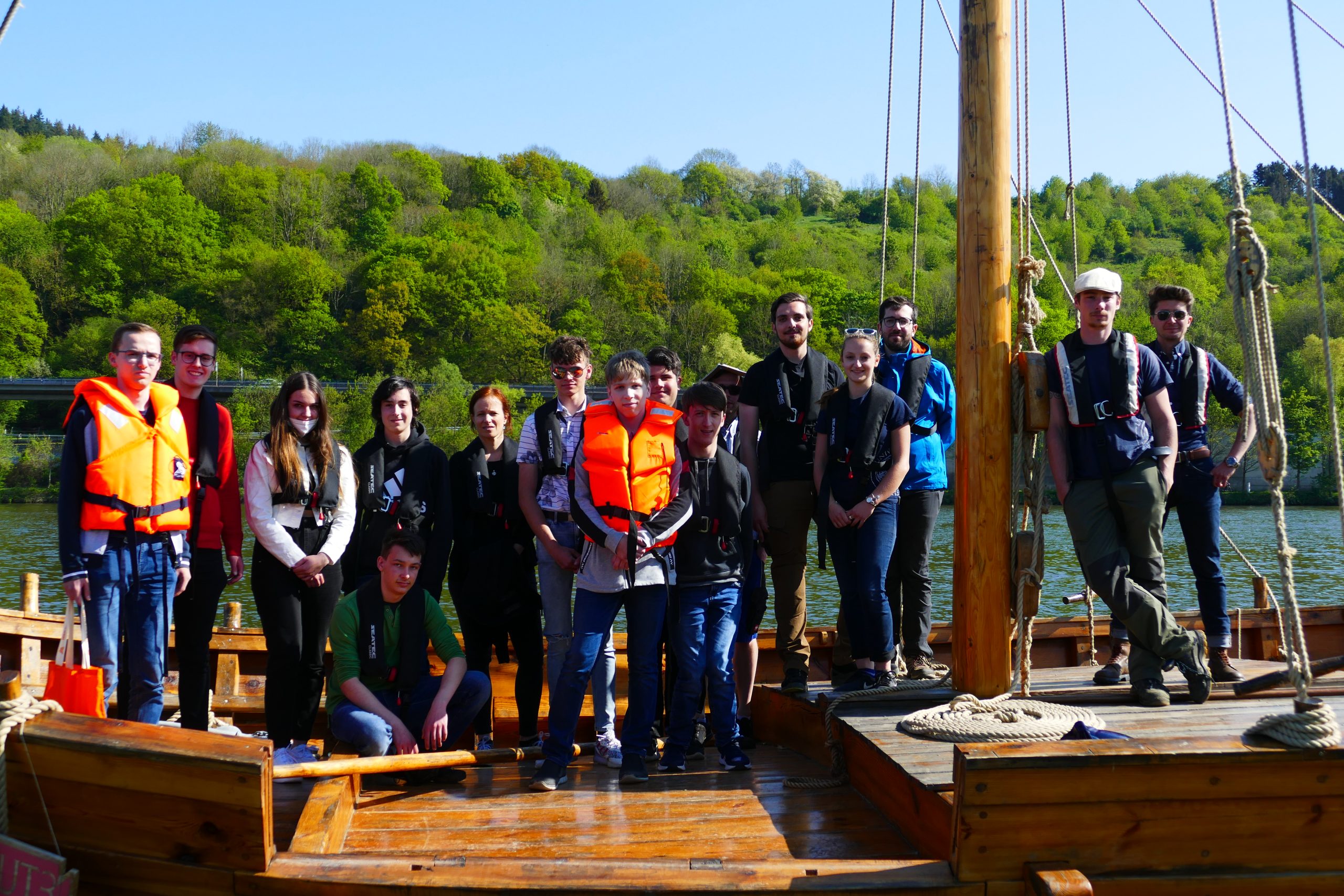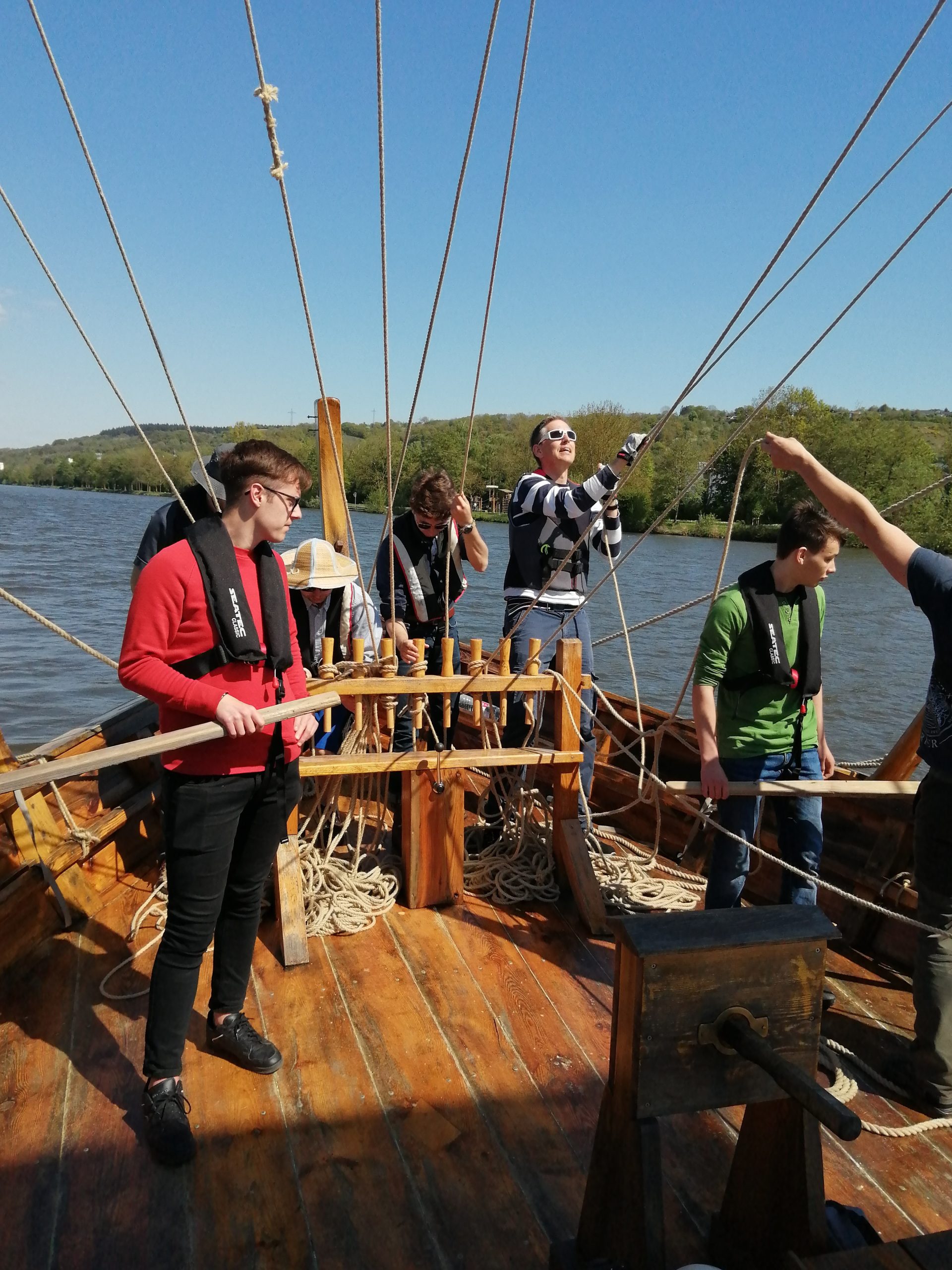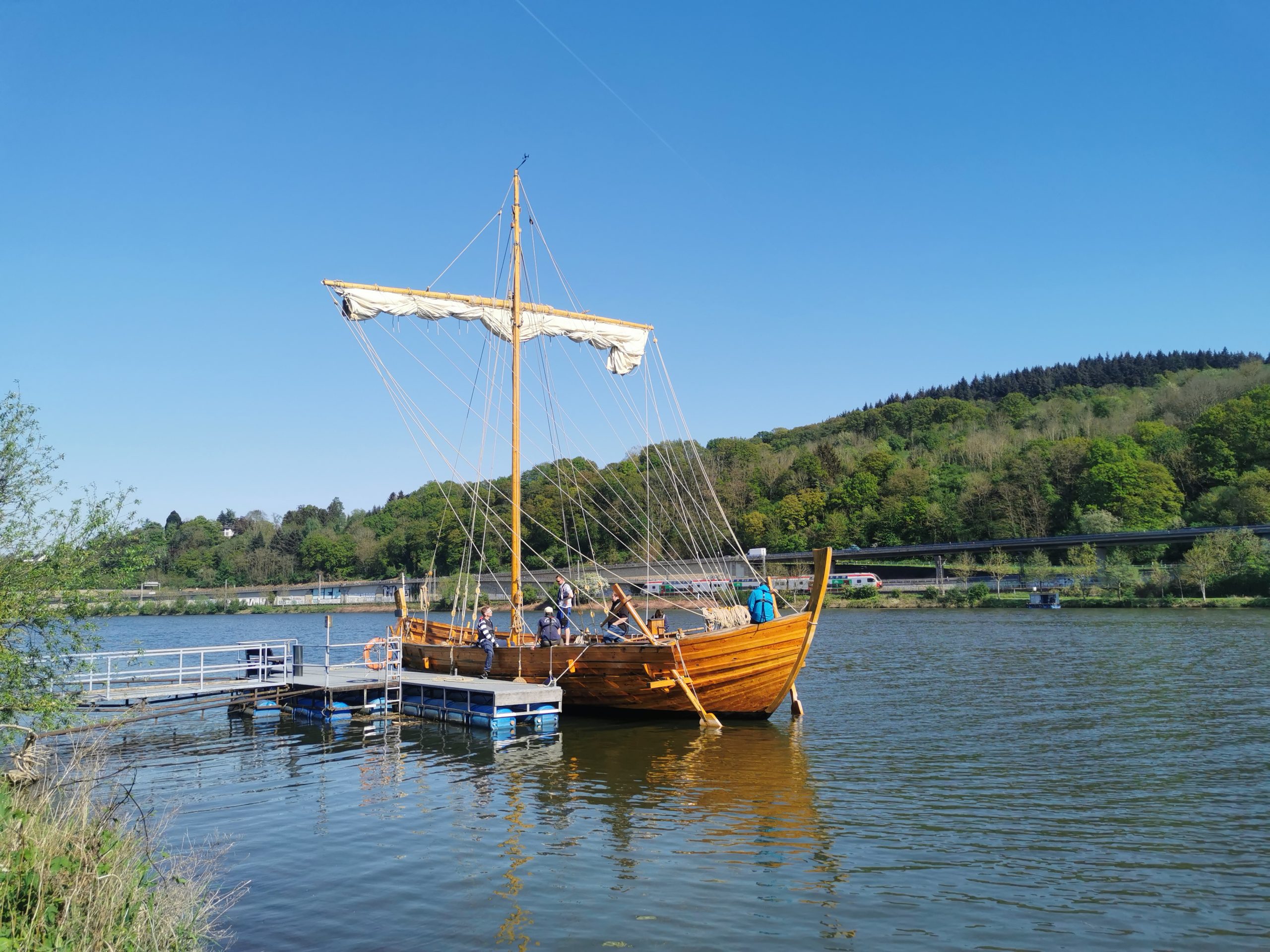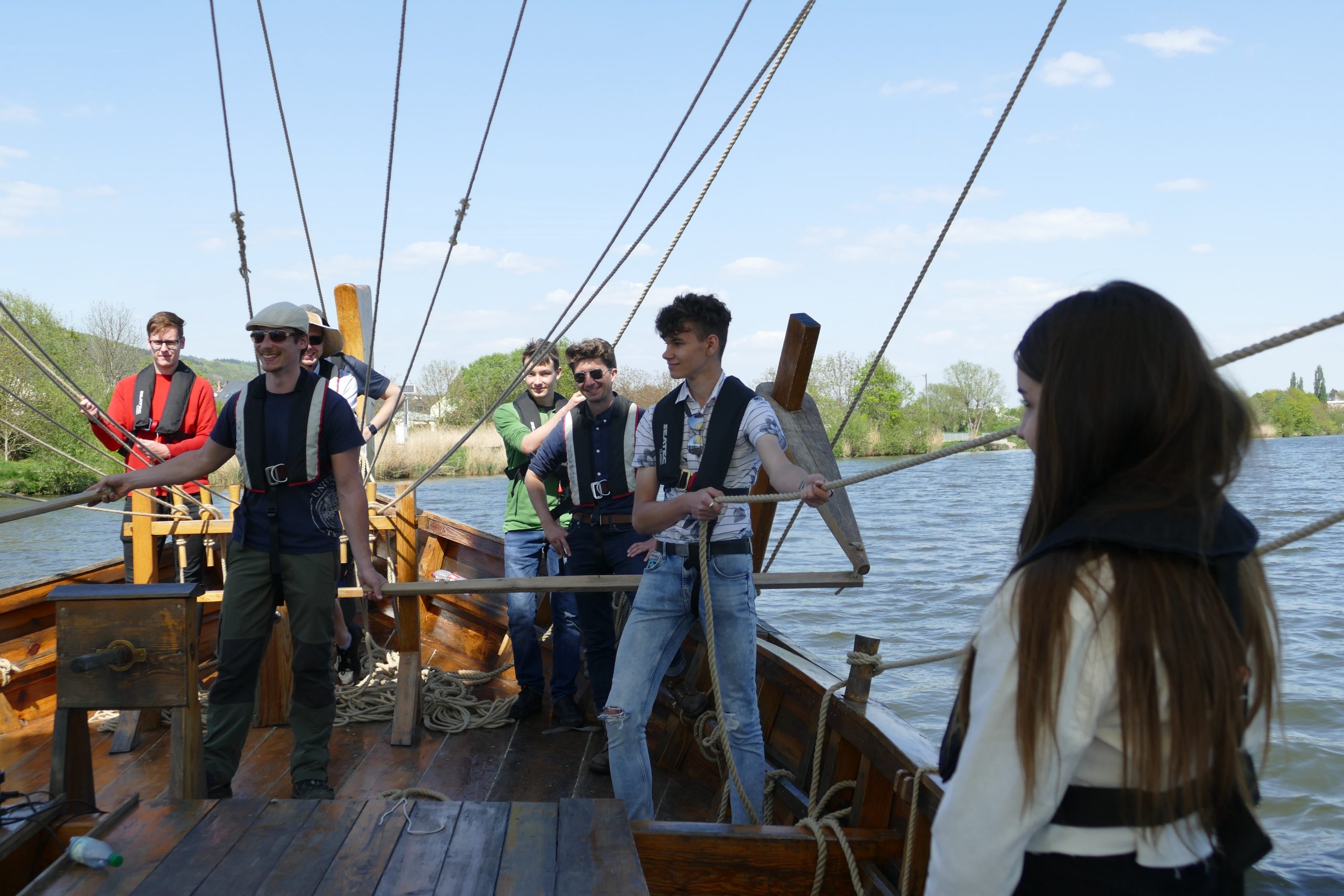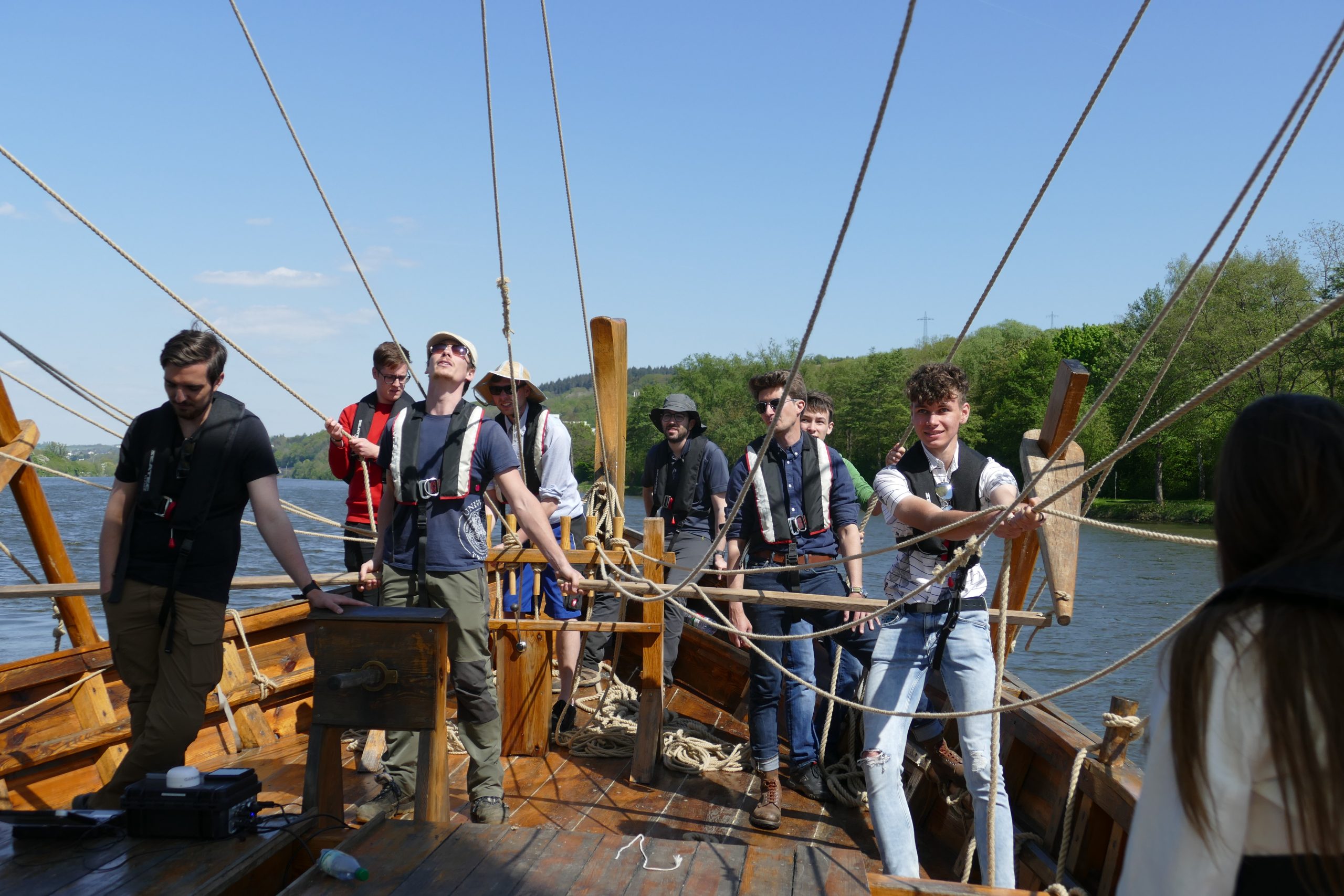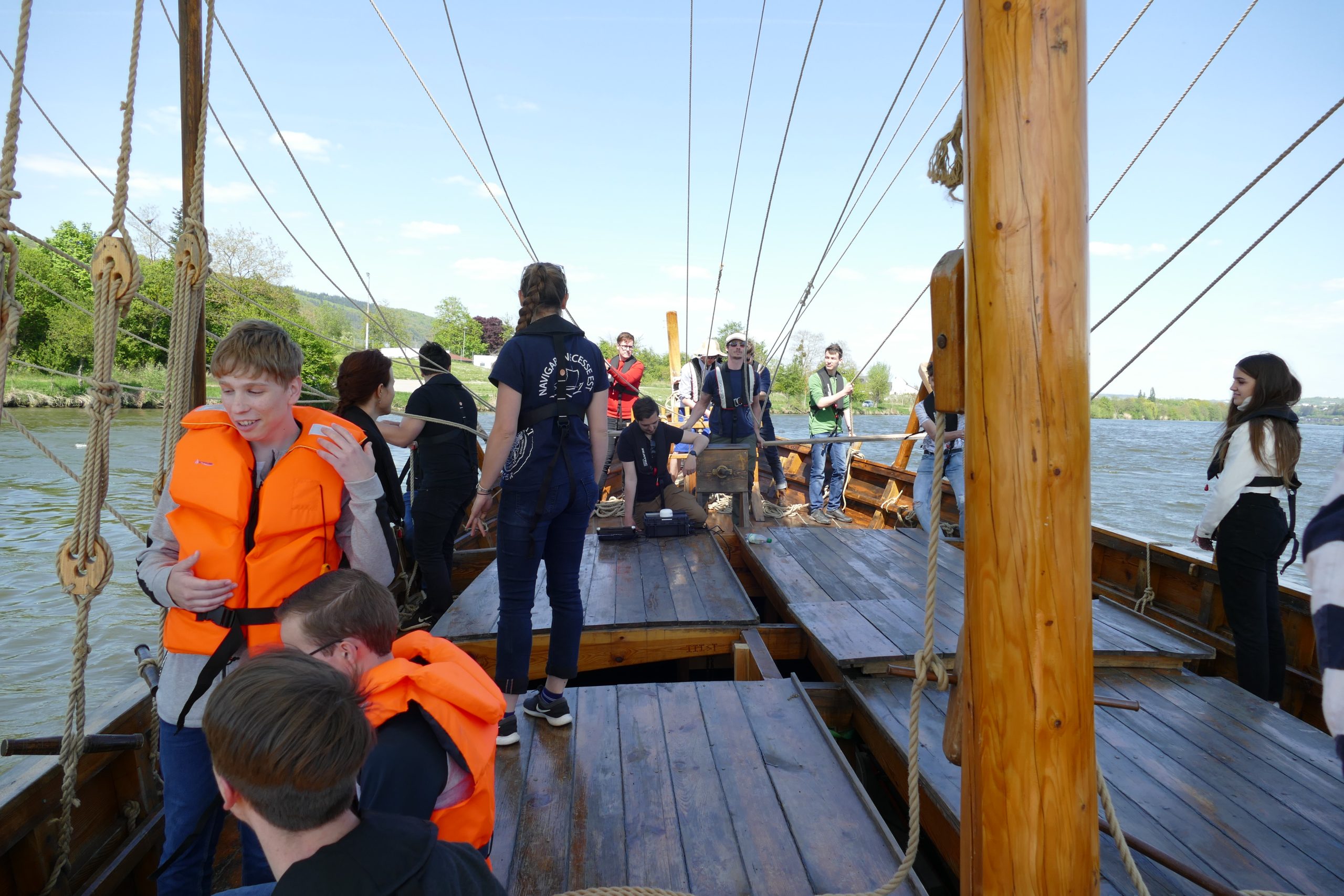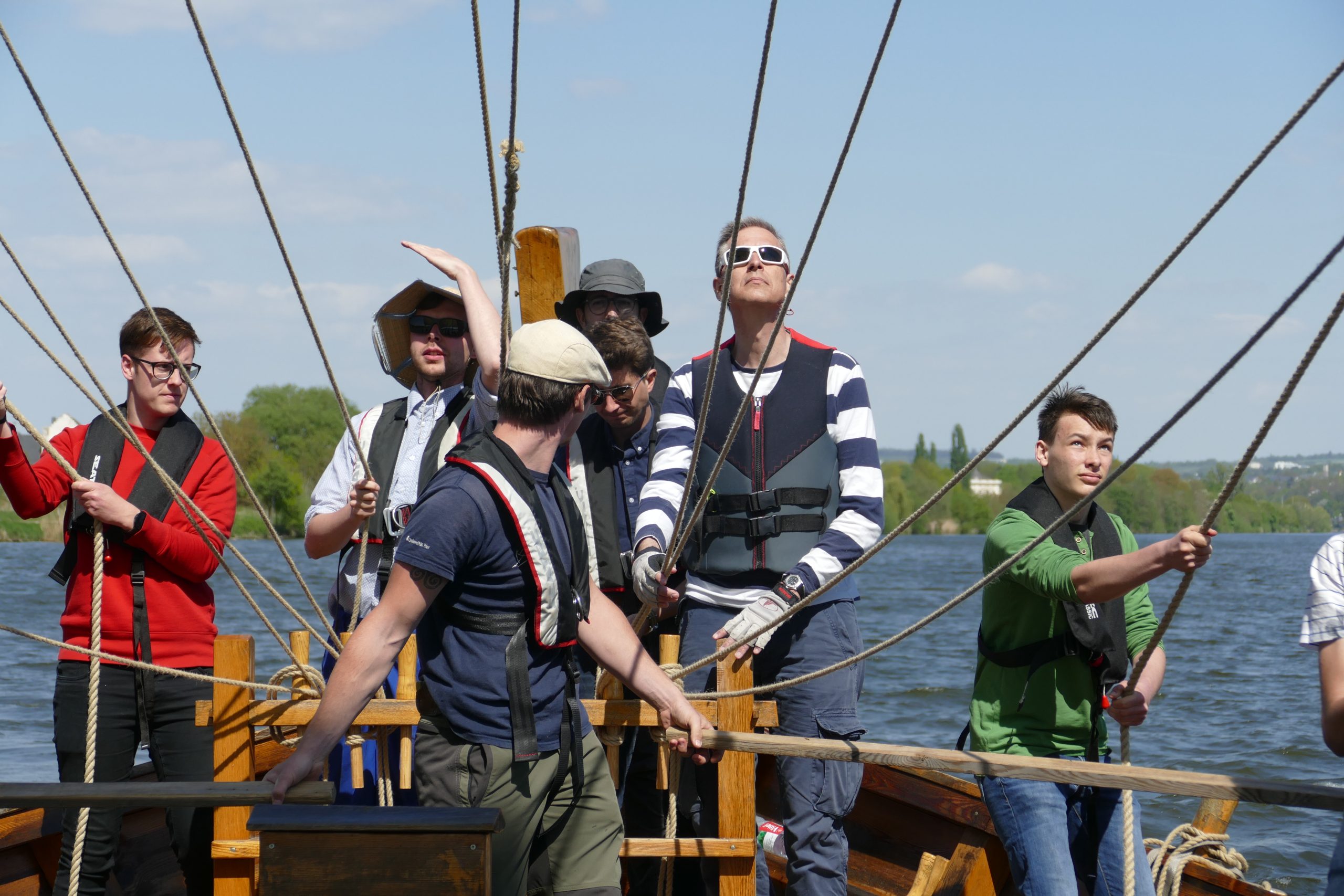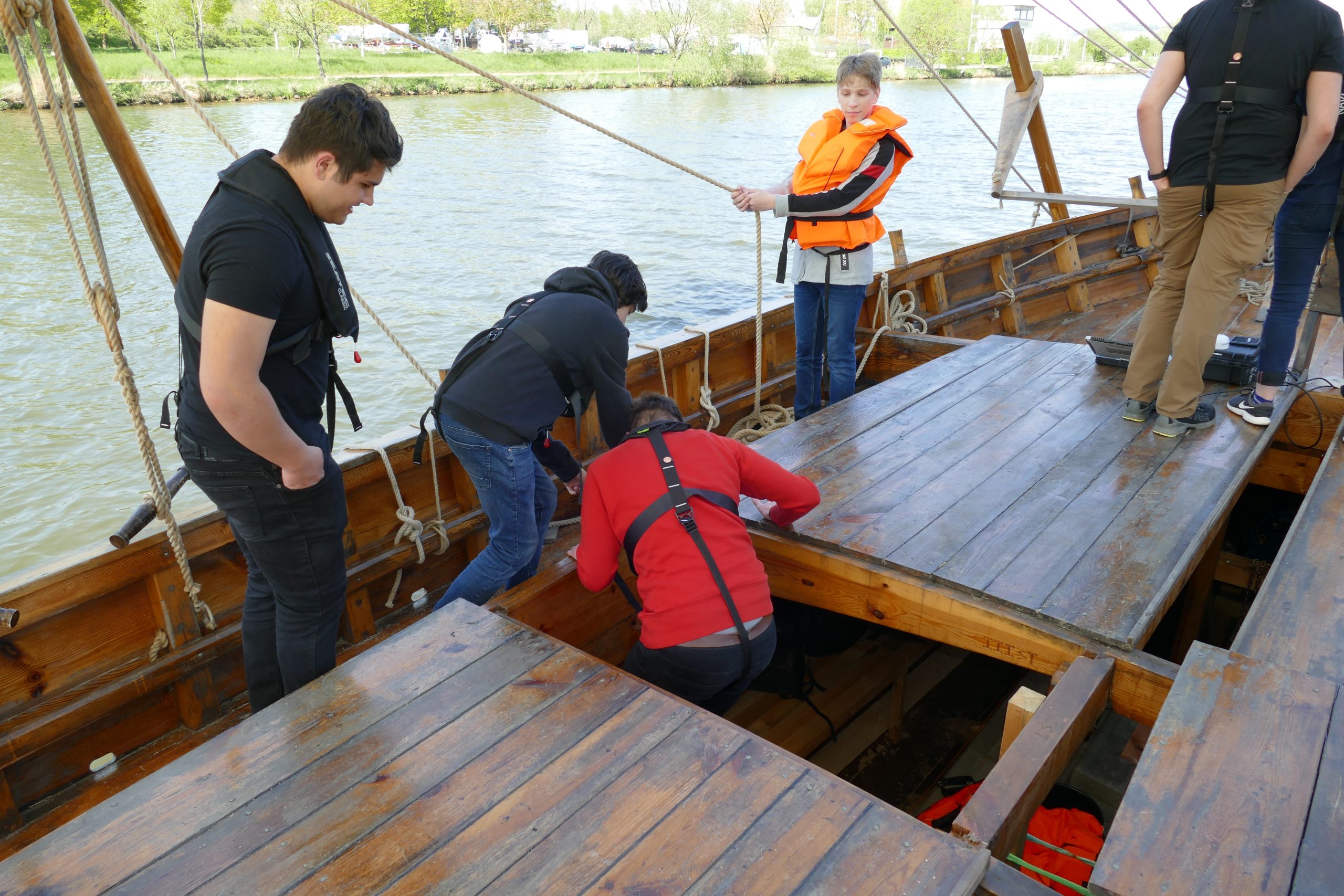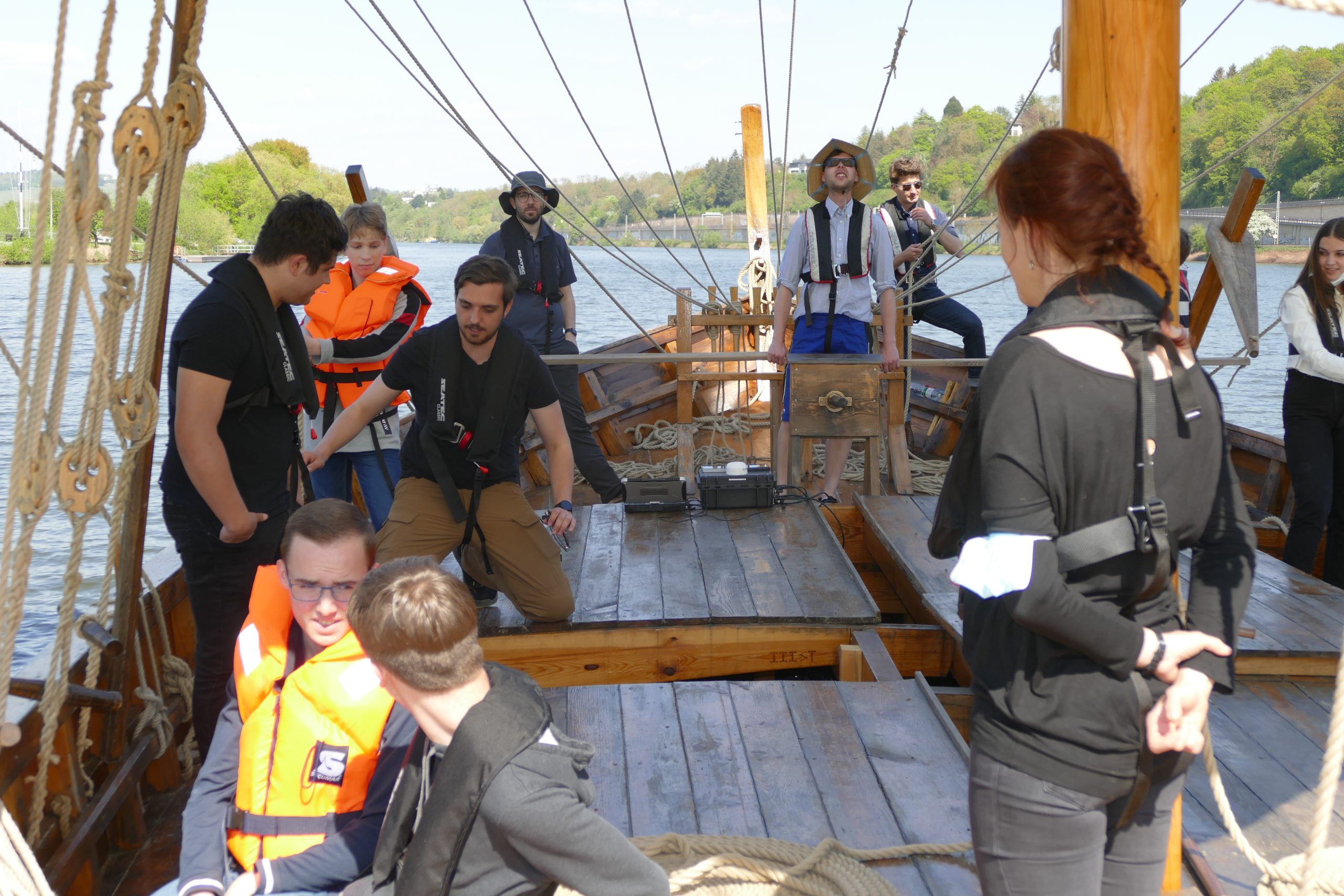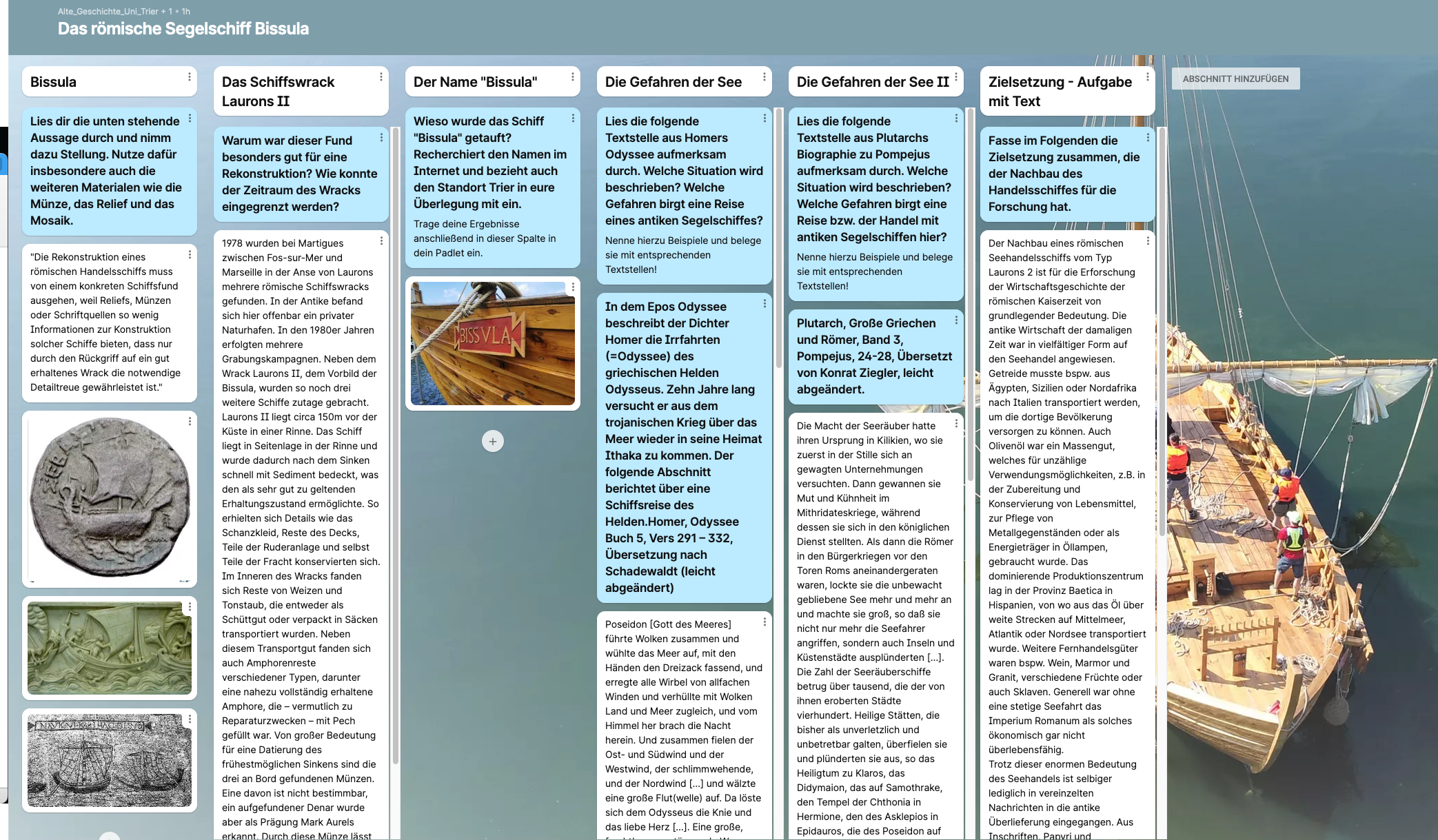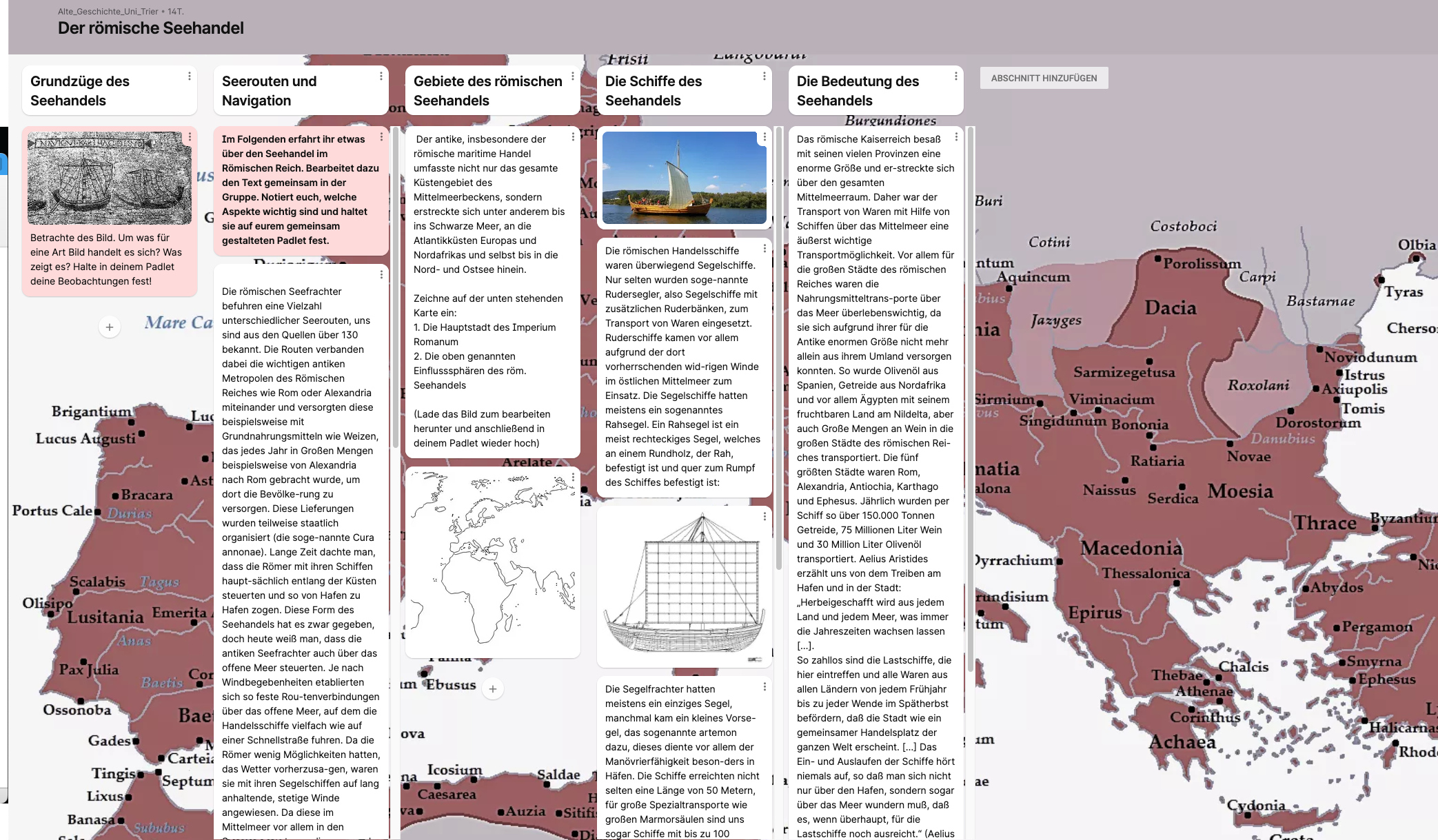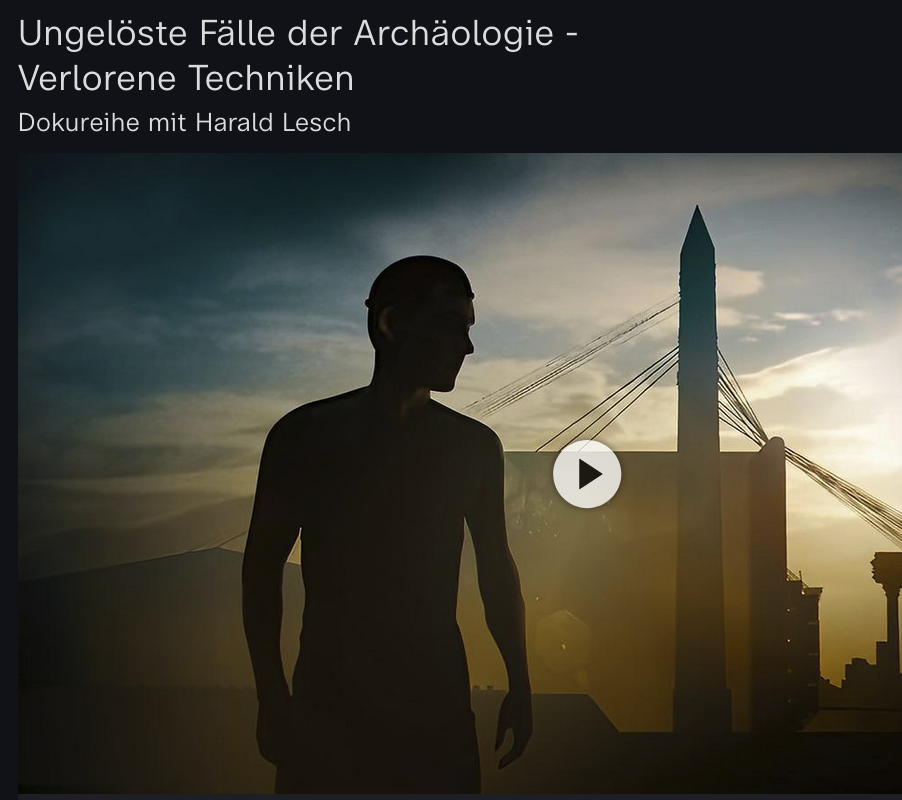Bissula – a Roman merchant ship
The Bissula is a 1:1 replica of a Roman merchant ship of the type Laurons II, which was built 2017 – 2019 in a project of the University of Trier and the University of Trier together with students of different disciplines, funded by the German Research Foundation. Below you can explore the Bissula from the discovery of the ancient model to its relevance for research today!
Discovery of the wreck of Lauron II
In 1978, several Roman shipwrecks were found near Martigues between Fos-sur-Mer and Marseille in the Anse of Laurons. In ancient times there was apparently a private natural harbor here. Several excavation campaigns took place in the 1980s. In addition to the wreck of Lauron II, the prototype of the Bissula, three other ships were unearthed. Laurons II is located about 150 m offshore in a channel. The ship lies in a lateral position in the channel and was thus quickly covered with sediment after sinking, which allowed the state of preservation, which is considered to be very good. Thus, details such as the bulwark, remnants of the deck, parts of the steering gear and even parts of the cargo preserved. Inside the wreck were found remnants of wheat and clay dust, which were transported either in bulk or packed in bags. In addition to this transport material, amphora remains of various types were also found, including an almost completely preserved amphora that was filled with pitch – presumably for repair purposes. Of great importance for a dating of the earliest possible sinking are the three coins found on board. One of them cannot be determined, but a denarius that was found was recognized as a coinage of Marcus Aurelius. By this coin, the earliest possible sinking of the ship can be dated to 161. A.D. date.
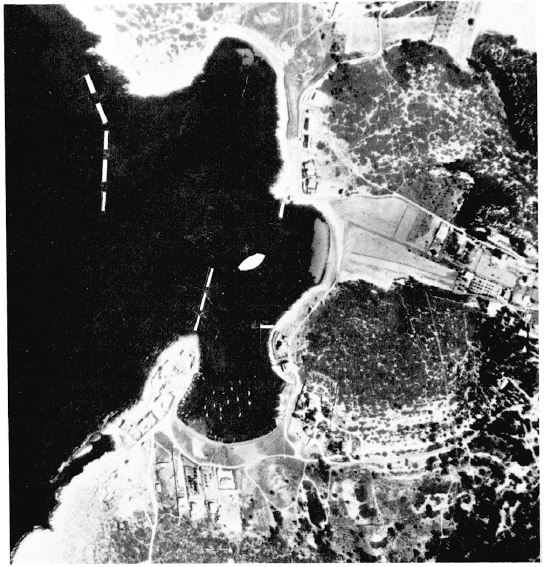
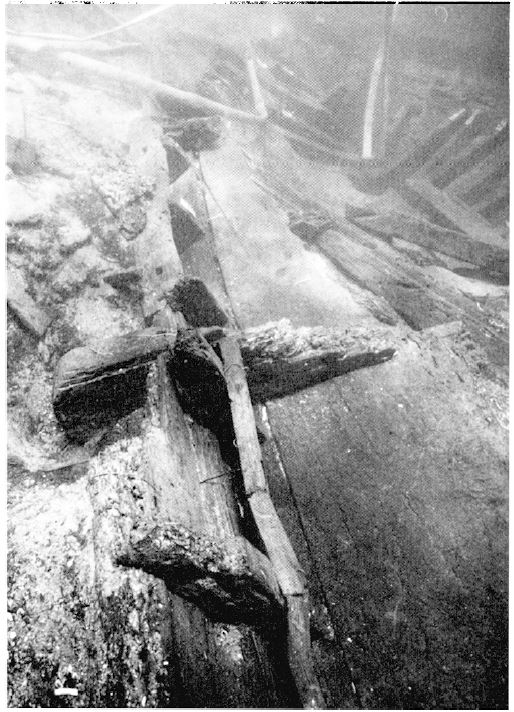
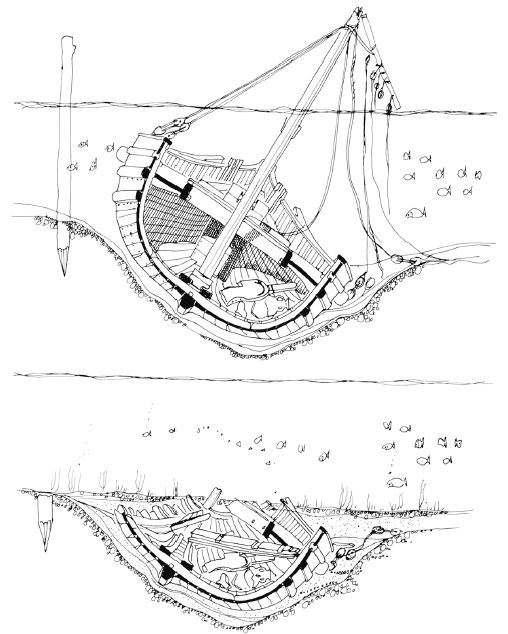
Photos from: Gassend Jean-Marie, Liou Bernard, Ximénès Serge. L’épave 2 de l’anse des Laurons (Martigues, Bouches-du-Rhône).
In: Archaeonautica, 4, 1984. pp. 75-105.
Research project
The reconstruction of a Roman maritime merchant ship of the type Laurons II is of fundamental importance for research into the economic history of the Roman imperial period. The ancient economy of the time relied on maritime trade in many ways. Cereals, for example, had to be from Egypt, Sicily or North Africa to Italy in order to supply the local population. Olive oil was also a bulk commodity, which was used for innumerable purposes, e.g. in the preparation and preservation of food, for the care of metal objects or as an energy source in oil lamps. The dominant production center was in the province of Baetica in Hispania, from where the oil was transported over long distances to the Mediterranean, the Atlantic or the North Sea. Other long-distance trade goods were, for example. Wine, marble and granite, various fruits or even slaves. In general, the Roman Empire as such was not economically viable without constant seafaring.
In spite of the enormous importance of maritime trade, it is only mentioned in a few isolated reports in the ancient tradition. From inscriptions, papyri and legal sources we know relatively well the actors of the trade, i.e. seafarers, sailors, merchants, ship owners, lenders and others. The prices of various products and goods have also been handed down in isolated cases through inscriptions and graffiti, but especially through papyri. However, based on the still generally fragmentary source material, it is not yet possible to provide a precise cost analysis for long-distance trade in the Roman imperial period. The main goal of the project is to obtain information about ancient maritime trade through the analysis of the ship’s performance data, especially its sailing characteristics, which, as a core element of the transport of goods, allows us to grasp the Roman economic system more precisely. The question behind this is to what extent the Roman economy already exhibited traits of globalization and what long-term effects can be observed as a result in the perspective of long duration – a question that can give us food for thought especially today.
In order to determine the performance data of the Bissula, which are of immanent importance for the given problem, the Bissulla is currently being tested on the Moselle near Trier. The initial phase of the test series since the ship’s launch in July 2019 served primarily to test the measurement systems and methodology and, in particular, to train the ship’s crew, which consists of interested students, student and research assistants as well as research assistants up to professors.
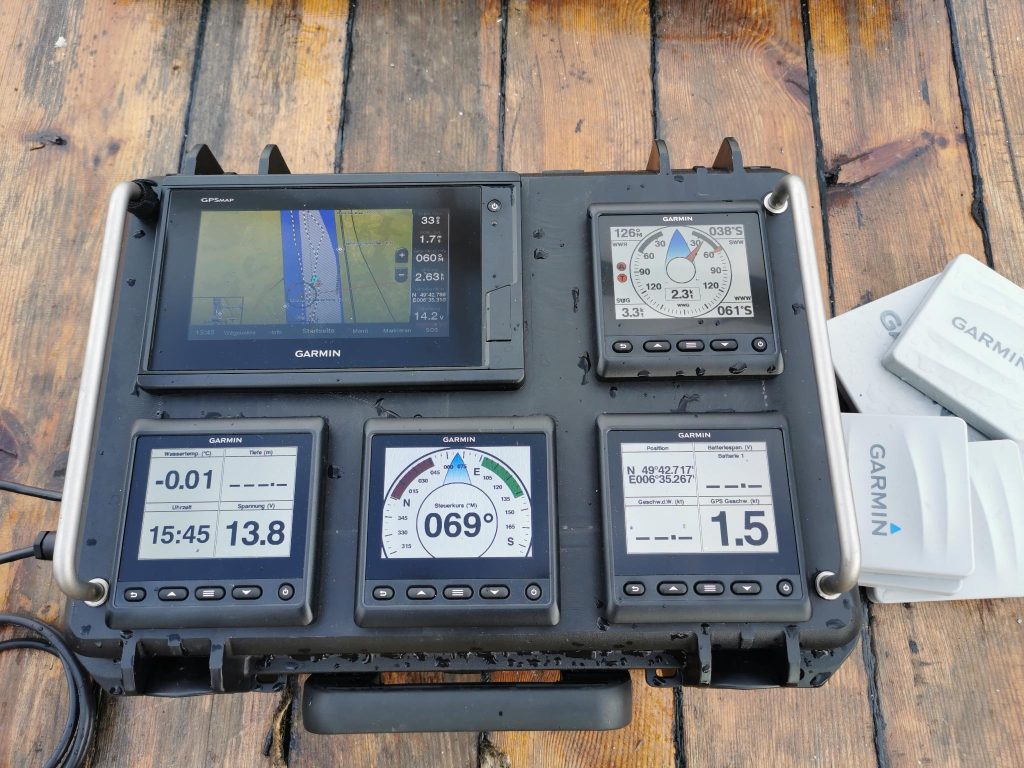 Measuring case as used on the Bissula during driving tests on the Moselle.
Measuring case as used on the Bissula during driving tests on the Moselle.
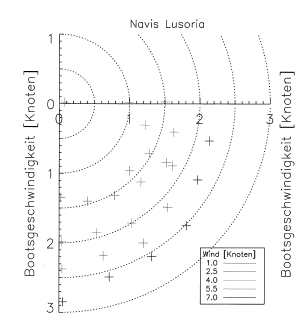
Here is an exemplary representation of a polar diagram from earlier ship tests by Prof. Dr. Christoph Schäfer
Since the end of 2021 – as with so many projects, there were delays due to the corona pandemic – the training of the ship’s crew can be described as complete and the measurement technology as established. Since then, the Bissula has been put through its paces on the Moselle and measurement data has been collected. The electronic measuring system stores all relevant values three times per second, including wind direction, wind speed, speed through the water, speed over ground, course over ground, heading and GPS position. External influences such as the flow of the Moselle are filtered out of the data and a so-called polar diagram is developed, which depicts the performance data of the ship, i.e. which ship speed is achieved at which wind speed depending on the wind angle.
Since the Bissula, with a length of approximately 16 meters and a width of five meters, is not a small river ship but a cargo ship suitable for the high seas, it is very difficult to obtain all the required measurement data on the Moselle. Relevant for the research are not only the top speed at good courses to the wind (i.e. space sheet or downwind, when the wind hits the ship from behind and the sail can be fully blown), but rather the question up to which wind angle or course to the wind the ship can still make speed or is maneuverable. For the simulation of routes in the Mediterranean Sea, even ten degrees would be immense here! To be able to set such courses, the navigation channel of the Moselle is unfortunately much too small for the ship.
In order to circumvent this problem, the Bissula was on the one hand replicated in 1:3 scale, so that the test series can be completed with the significantly scaled-down replica (for further information see „1:3 replicas“), and on the other hand the Bissula is to be relocated to the Mediterranean in late summer 2023 in order to complete the test series under significantly better and more realistic conditions.
Reconstruction and construction
The decisive factor for the reconstruction of the ship under the direction of Christoph Schäfer was, on the one hand, the exceptionally good state of preservation of the ship and, on the other hand, its relatively compact size of 16 m in length and 5 m in width. This, unlike large „super freighters“, allowed both the feasibility of the project and the transport of the ship to the Moselle, as the ship was built on the university’s premises in a purpose-built construction hall. The advantage of the building location directly at the university was the networking with university teaching and research seminars, which at the same time made it easier for interested students to participate in this extraordinary project. Before construction actually began, the well-documented wreck data from Gassend and crack drawings by Ronald Bockius were used to reconstruct data models and construction plans with the cooperation of Trier University of Applied Sciences, according to which the ship was finally built.
This is where Michael Hoffmann’s department at Trier University of Applied Sciences did valuable work: based on the construction plans, a 3D model was created, which also helped to eliminate minor inconsistencies in the line outlines. AR glasses „projected“ the ship into the construction hall, allowing people to use virtual plans of the ship during the construction phase to facilitate real-world replication. With the help of VR goggles, the ship was digitally reconstructed during the keel-laying ceremony and could thus be experienced by the visitors.
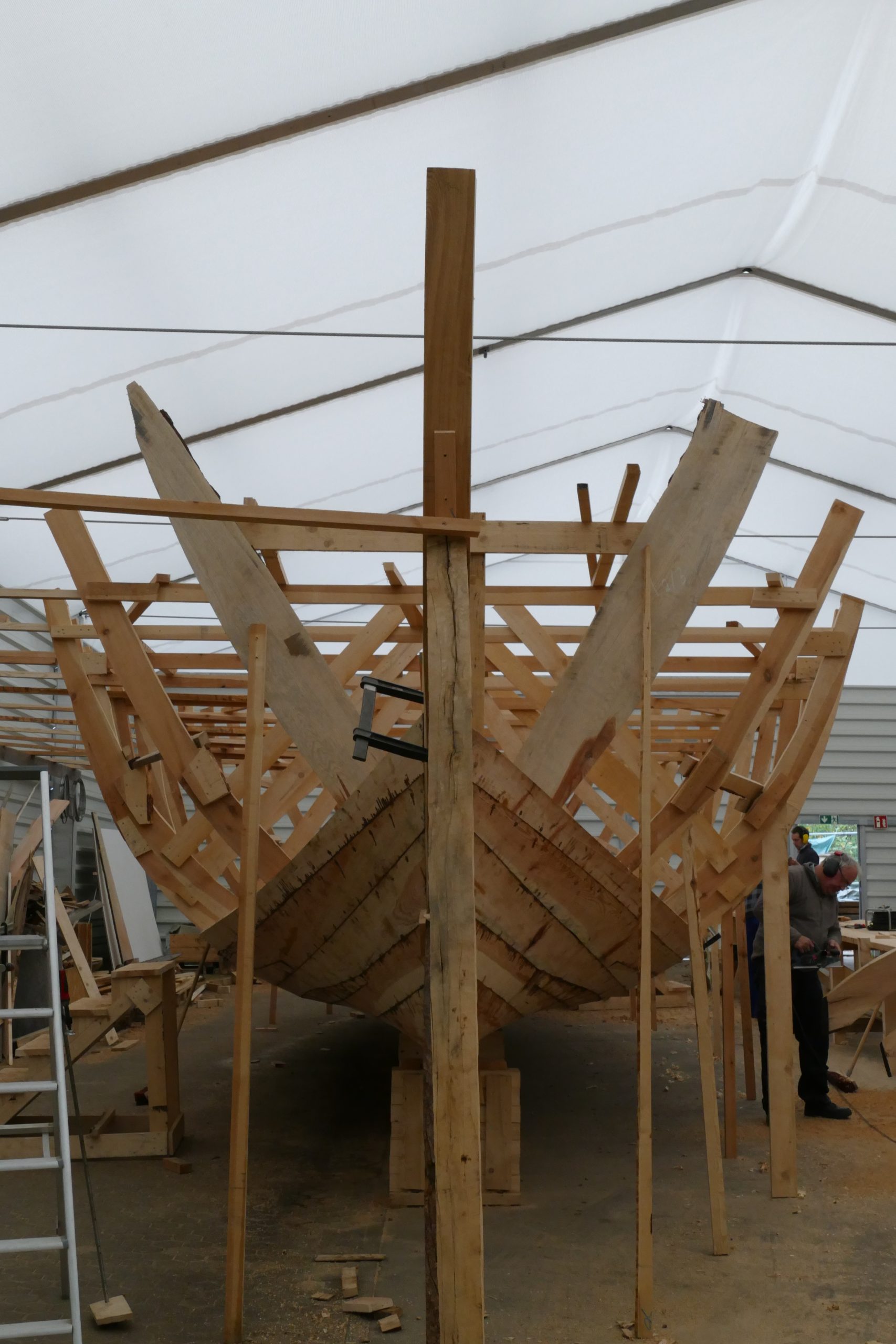
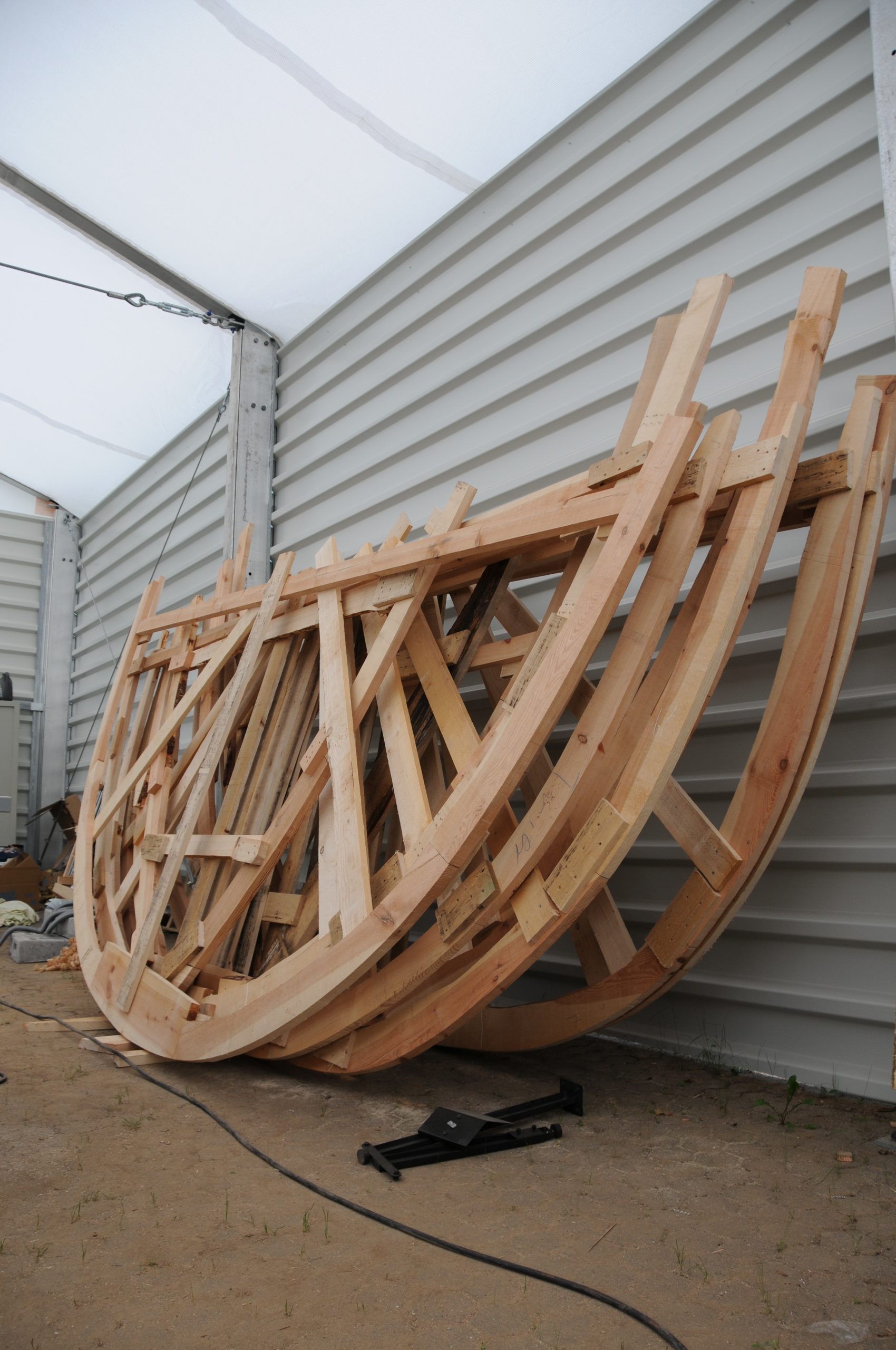
Transportation
On June 05, 2019, the time had finally come: the ship, which up to this point had still not been named, was brought from the construction hall, which is located on the grounds of the University of Trier, to the Moselle in a complex process with the help of a heavy-duty transport. Extensive preparatory work had to be carried out for this: Among other things, the roof and entrance gate of the construction hall were removed and the ship prepared for transport. Using a heavy-duty crane from the Steil company, the Bissula was lifted onto a remote-controlled low-loader and lashed down. In the evening around 22 o’clock the journey began, which ended around 05 o’clock with the arrival at the construction yard of the Wassterstraßen- und Schifffahrtsamt. The Trier police temporarily closed roads for this transport, which had to take a considerable detour through Trier due to bridges that were too low.

Ship christening
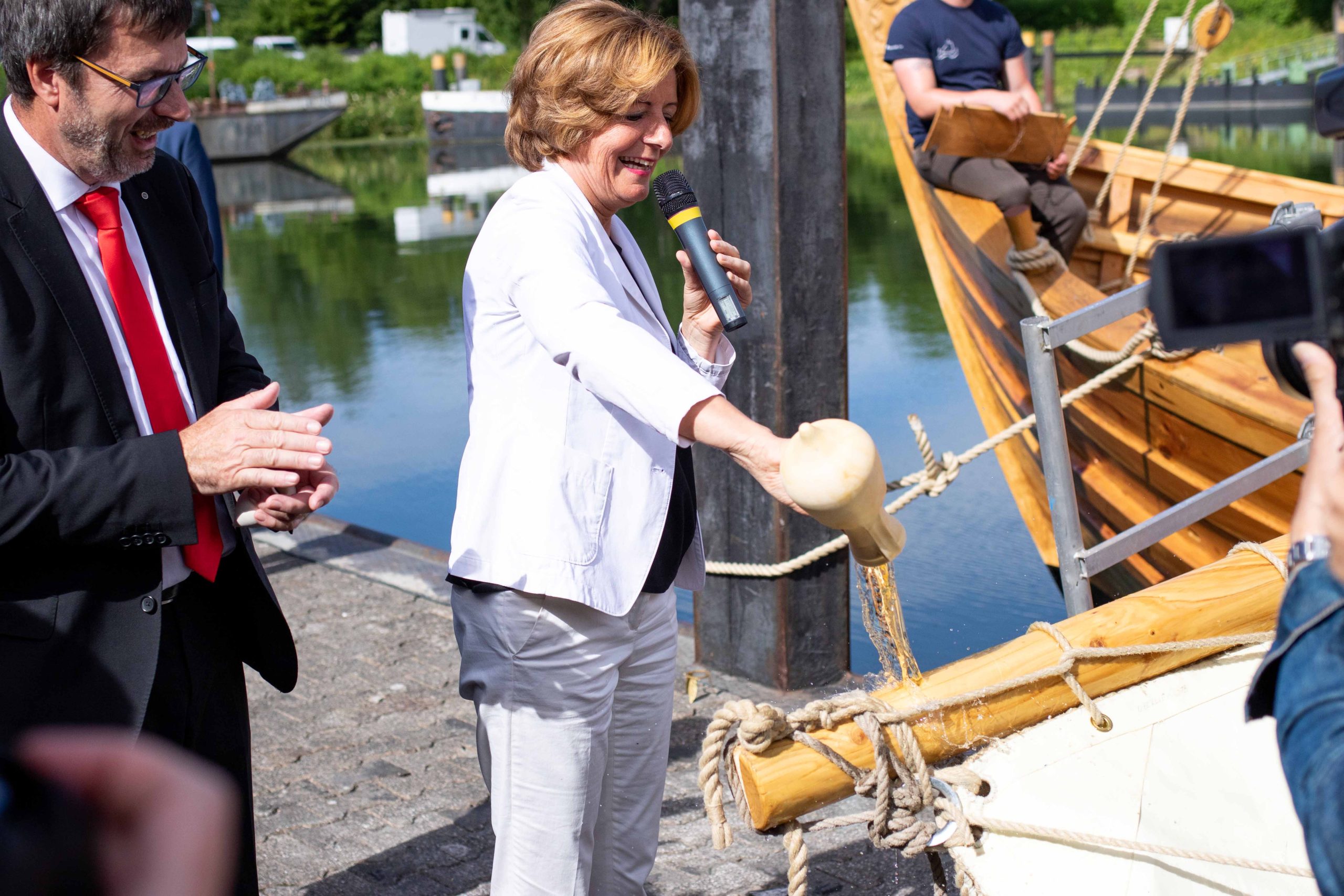 On 05 July 2019, the ship was christened „Bissula“ in a ceremony at the construction yard of the Waterways and Shipping Authority in Trier. The ship was christened by Malu Dreyer, Minister President of Rhineland-Palatinate, who said in her speech at the christening: „It is an apt symbol of the special qualities of the city of Trier and the entire region. The realization of the project impressively confirms that we have a high-performance and innovative science location in Trier, which will once again be sustainably strengthened by the project. In addition to the historical aspects, I am personally impressed by the fact that students from the university and other helpers have invested a great deal of time in the project on a voluntary basis. It’s great to see how committed they are. This deserves recognition and for this I would like to expressly thank you as well as all the other people responsible and involved.“ The President of Trier University, Prof. Dr. Dorit Schumann, the President of the University of Trier, Prof. Dr. Michael Jäckel, and the Mayor of Trier, Wolfram Leibe, also attended the ship’s christening as guests of honor and praised the Laurons II project in their speeches.
On 05 July 2019, the ship was christened „Bissula“ in a ceremony at the construction yard of the Waterways and Shipping Authority in Trier. The ship was christened by Malu Dreyer, Minister President of Rhineland-Palatinate, who said in her speech at the christening: „It is an apt symbol of the special qualities of the city of Trier and the entire region. The realization of the project impressively confirms that we have a high-performance and innovative science location in Trier, which will once again be sustainably strengthened by the project. In addition to the historical aspects, I am personally impressed by the fact that students from the university and other helpers have invested a great deal of time in the project on a voluntary basis. It’s great to see how committed they are. This deserves recognition and for this I would like to expressly thank you as well as all the other people responsible and involved.“ The President of Trier University, Prof. Dr. Dorit Schumann, the President of the University of Trier, Prof. Dr. Michael Jäckel, and the Mayor of Trier, Wolfram Leibe, also attended the ship’s christening as guests of honor and praised the Laurons II project in their speeches.
During the celebration that followed, there was an opportunity for the many guests who attended to go out and explore the Bissula and to exchange ideas with those involved over a drink and a meal.
DIMAG
The project „Digital Interactive Maritime History Atlas“ is closely related to the Bissula and the 1:3 reconstructions. This is because the aim of the DFG long-term project with a funding period of 3×3 years is to obtain new insights into ancient economy and maritime connectivity in general on the basis of nautical simulations. For this purpose, the measurement data of the bissula and the reconstructions are of great importance, because with these performance values in connection with a route simulation software a digital atlas is developed as a web tool, on the basis of which historians as well as historically interested persons can have important routes calculated for them. For example, one can determine how long a trip may have taken from Alexandria to Ostia at a given time of year.
Promotion
Due to the size and scope of the project, it would not have been possible for the Chair of Ancient History at the University of Trier, headed by Prof. Dr. Christoph Schäfer, to carry out the project without external funding and support. The Laurons II project was and is funded by the Nikokaus Koch Foundation and in particular by the German Research Foundation.
The project was also supported by the city of Trier and the Trier Forestry Office, which provided the wood for the construction of the bissula. Holzland Leyendecker and the company Hees and Peters played a decisive role in cutting the wood and by lending the working equipment free of charge. Support for the project also came from the German Armed Forces‘ WTD 41, the Trier Chamber of Crafts, especially Rudi Müller, as well as Peter Stephanus, Ulrich Hagemann and Markus Weber. Grants came from the Ausonius Verein zur Förderung der Altertumswissenschaften at the University of Trier. The ship christening was also supported by the Neumagen Wine Ship Sponsoring Association.
Finally, special thanks go to the Federal Waterways and Shipping Administration, especially the Mosel-Saar-Lahn Waterways and Shipping Office, on whose construction yard at the Trier site not only the watering and christening of the ship could take place, but since then the Bissula has also had a berth at its disposal.






School projects
The Bissula is a unique project – and not only for the specialized scientific research of maritime connectivity and economy, but also with regard to the design of school lessons! On the one hand, the Bissula represents a unique extracurricular place of learning, where an ancient sailing ship can not only be viewed – as in a museum – but also actively experienced, thus creating a better historical awareness of antiquity or ancient life reality. Within the framework of a project sponsored by the NCP, it was possible to provide various school classes, including history and Latin courses of the upper secondary school, but also the middle school of a special school, with a certainly unique teaching unit at an extracurricular learning object. The students themselves slipped into the role of ancient seamanship and took over the rudder and sails after and under the guidance of the crew of the research ship. During the breaks in sailing – i.e. when the ship was sailing back against the wind under motor – the professors and research assistants provided the students with further information about shipbuilding, Roman maritime trade and everyday life in antiquity. In the subsequent conversations with the students, further questions developed which were discussed together.
On the other hand, the project not only made the Bissula accessible as an extracurricular place of learning, but also provided didactically prepared content on the subject of the Bissula and Roman maritime trade. This was done by using padlets, which are linked below this section, and on the other hand by creating the „interactive bissula“ on this page.
Press review
Course to antiquity
„Shortly thereafter on this gray autumn morning, the ship glides ponderously onto the Moselle River south of Trier. The men set sail and turn off the engine. Now they hope the wind will do its work, as it did when ships like this carried wine and olive oil across the Mediterranean in the 2nd century AD.“
Roman ship: „Bissula“ explains the economic history
In recent years, the University of Trier has developed into a leading location for experimental archaeology. The most spectacular project in this line of research to date is the faithful reproduction of a 16-meter-long Roman merchant ship (we reported). Rhineland-Palatinate’s Prime Minister Malu Dreyer has now christened it „Bissula“ in Trier, the mistress of the Roman poet Ausonius. Ancient historian Prof. Dr. Christoph Schäfer is the driving force behind the reconstructions of ancient models.
Link to the article on Wochenspiegellive.de
Sailing like the Romans: Researchers recreate ancient merchant ship
Tracing the knowledge of early captains: German scientists have reconstructed a seagoing Roman sailing freighter. It will provide data on the performance of the ancient merchant ship.
„The Romans were already living in a globalized world“
How did goods get from one end of the Roman Empire to the other in a flash? To explore this, archaeologists are now becoming boat builders and sailors themselves.
Link to the article on Süddeutsche.de
„Bissula“: Dreyer christens replica Roman ship
Rhineland-Palatinate’s Prime Minister Malu Dreyer (SPD) christened the first reconstructed Roman merchant ship „Bissula“ in Trier on Friday. This was announced by the University of Trier on its homepage. More than 80 researchers had spent around two years building the sailing ship in a hall on the university parking lot in Trier.
Link to the article on Süddeutsche.de
Trier, the Roman ship and the mistress
Big performance for Bissula. The faithful replica of a Roman merchant ship was christened on Friday by Minister President Malu Dreyer. The second part of the spectacular research project is now beginning on the Moselle.
Link to the article at Trierischer Volksfreund

